Did you know that bay horses have “the most” common coat color in the equine world?
The color bay has been said to be the “Plain Jane” of horse coloring. However, it is a favorite of many equestrians, and the color bay can come in an assortment of shades and variations.
If you are taking lessons and riding horses, you will surely come across a bay horse at some point.
Are you able to tell the difference between an actual bay horse and a lookalike? Or know the specific type of bay horse you are working with?
We’ll see!
Keep reading to learn what makes a horse bay, the genetics behind the color, the shades of bay, and more. Plus, famous bay horses, quick facts, and test your knowledge at the end.
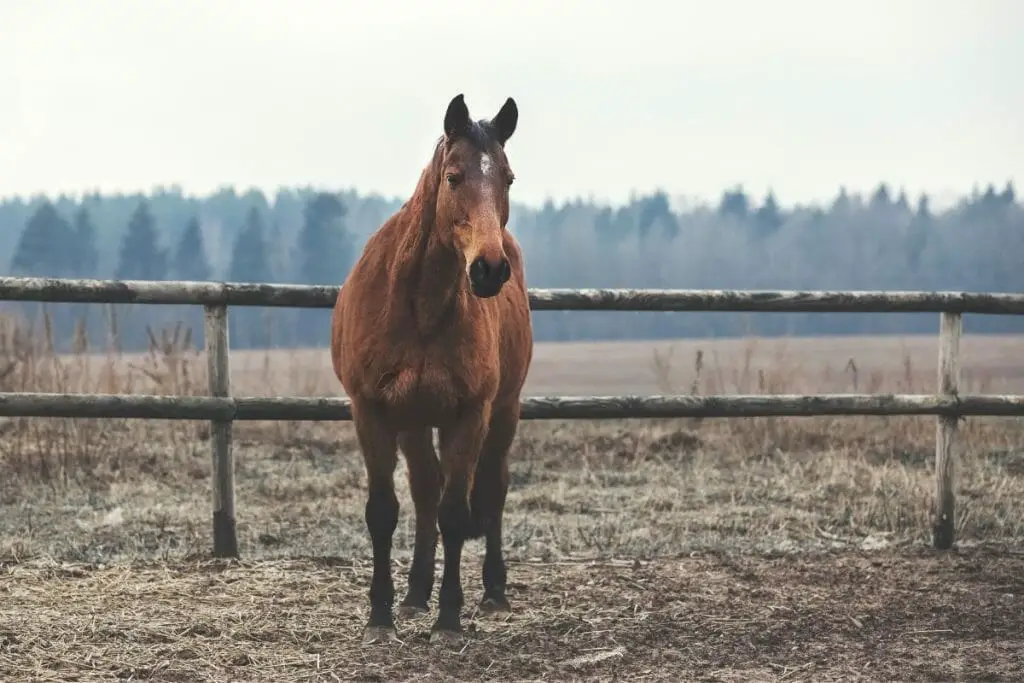
Table of Contents
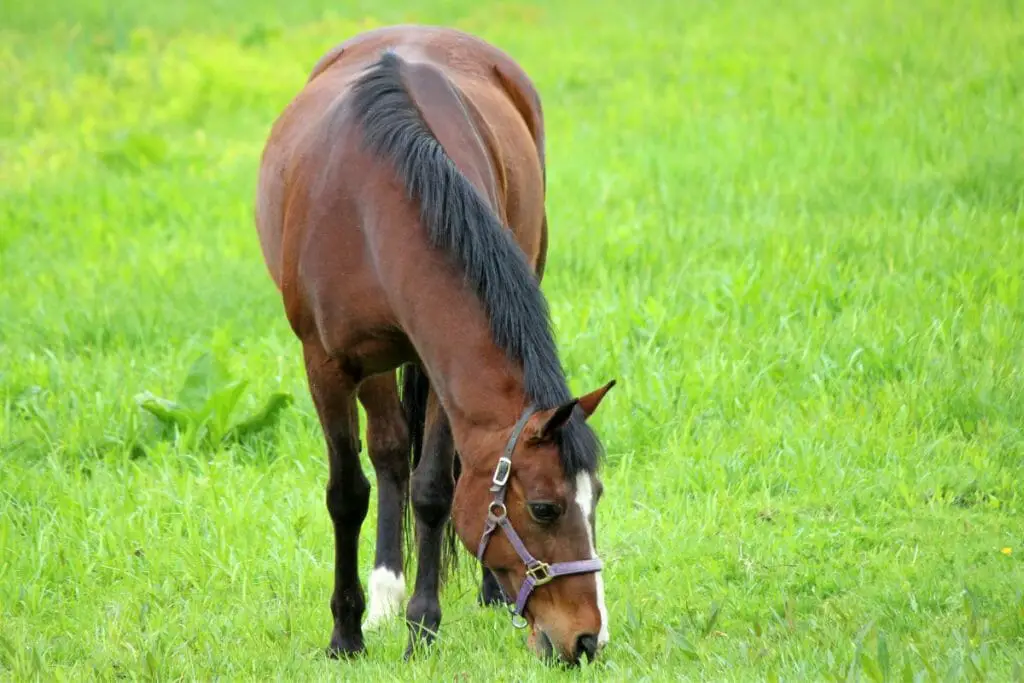
What Are Bay Horses? What Makes A Horse Bay?
The word “bay” is thought to come from the Old French word “baie,” meaning “brown.”
A bay colored horse has a reddish-brown coat and dark skin with a black mane, tail, ear tips, muzzle, and legs. They can have white markings on their head and legs. Bay horses can range from golden brown, reddish brown, and purple brown. Bay coloring can be seen on horses with pinto, roan, and spotted coat patterns.
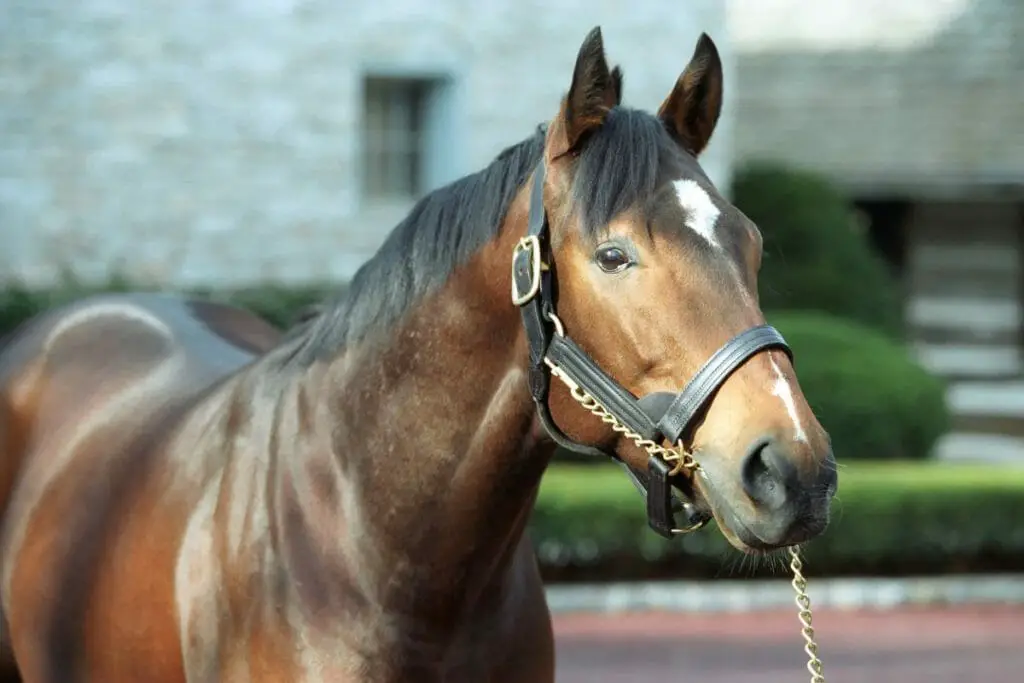
10 Things About Bay Horse Genetics
Learn all about the genetics of the bay coat color.
1. Two Base Pigments
All horse coat colors come from one of two base pigments: red or black. Bay comes from the black base.
2. Right Gene Combination To Be Bay
A bay horse must carry the right combination of the Extension gene and the Agouti gene in order to be considered genetically bay.
3. Extension Gene
The Extension gene, also known as the “Red Factor,” has two alleles, E and e, which are coded for either black or red pigments. Depending on the alleles the horse will be a red base pigment or a black base pigment.
4. Agouti Gene
The Agouti gene has two alleles, A and a, and directs where black pigment is found on the horse. This gene only visually affects horses with a black base pigment.
5. Dominant And Recessive Alleles
The Extension gene and Agouti gene can be dominant or recessive alleles.
Dominant Extension Allele: “E”
Recessive Extension Allele: “e”
Dominant Agouti Allele: “A”
Recessive Agouti Allele: “a”
6. The E Allele
The dominant E allele lets the black color show up. Because of this, all black and bay horses have at least one copy of the E allele, making them either E/E or E/e.
7. Bay Genotype Combinations
The mixture of the Extension and Agouti genotypes together can be a combination of the following to produce a bay horse.
Bay Extension Genotype: can be either EE or Ee
Bay Agouti Genotype: can be either AA or Aa
8. Homozygous and Heterozygous Traits
If a bay horse has two copies of the same allele for a gene, “AA” or “EE,” they are homozygous for that trait. Lowercase letters mean genes that are recessive and capital letters mean genes that are dominant. They are heterozygous for the trait if they have one dominant and one recessive allele such as “Aa” or “Ee.8. n”
9. Genetic Testing Needed For…
You can’t tell by looking at a horse whether it is heterozygous or homozygous for the agouti or not. You need genetic testing to find out.
10. The Bay Color Can Combine With Other Genes To Make Many Colors
When different color genes are added to the genes of bay horses, other colors can be made, with bay as the base template. One such gene is a dilution gene called the “cream gene.” This causes a bay horse to be a buckskin. This gene can double dilute in horses, meaning 2 cream genes with a bay base, and the horse would be a perlino.
Bay Color Genetics Chart
| Extension Gene | Agouti Gene | Genotype | Offspring Color |
| EE- Homozygous | AA-Homozygous | EE/AA | All foals will be bay if there are no additional modifying genes. |
| Ee- Heterozygous | AA-Homozygous | Ee/AA | Foals will be either chestnut or bay if there are no additional modifying genes. |
| EE-Homozygous | Aa- Heterozygous | EE/Aa | Foals will be either bay or black if there are no additional modifying genes. |
| Ee- Heterozygous | Aa- Heterozygous | Ee/Aa | Foals can be any color. |
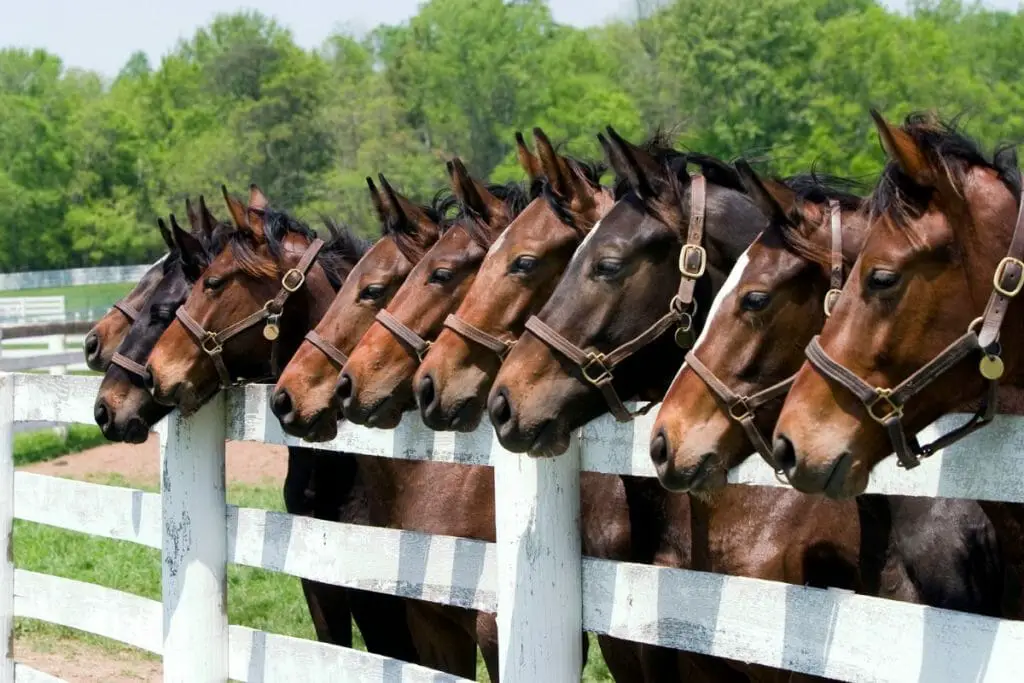
Bay Horse Color Variations
There are numerous terms used to describe the shades and characteristics of a bay coat. Some shade variations can be due to nutrition and grooming, but the majority appear to be caused by genetic characteristics that are still unknown.
Bay Color Variation Chart
| Bay Color Variation | Characteristics of Color |
| Standard Bay | Medium reddish-brown color with no darker or lighter hairs. |
| Wild Bay | Similar to a standard bay, but the black points only reach the pastern or fetlock. |
| Blood Bay | A horse with a medium blood-red tint of bay with purplish hues. |
| Cherry Bay | A lighter version of the very fiery and vibrant blood bay color. |
| Mahogany Bay | A very dark reddish brown bay similar to a deep mahogany color. |
| Light Bay | A light, washed-out, yellowish shade of bay. Similar to a lighter version of a standard bay. |
| Golden bay | A rare golden hue bay instead of the usual bay color. |
| Copper Bay | These horses are typical bays. This shade, though, is brighter, like a copper penny. Copper-colored horses have copper red to light copper red coats. |
| Dark Bay | Deep brown with a reddish body that looks almost black or very dark brown. |
| Seal Brown | Near-black body, black points, mane, tail, and legs; reddish or tan around eyes, muzzle, elbow, and stifle. |
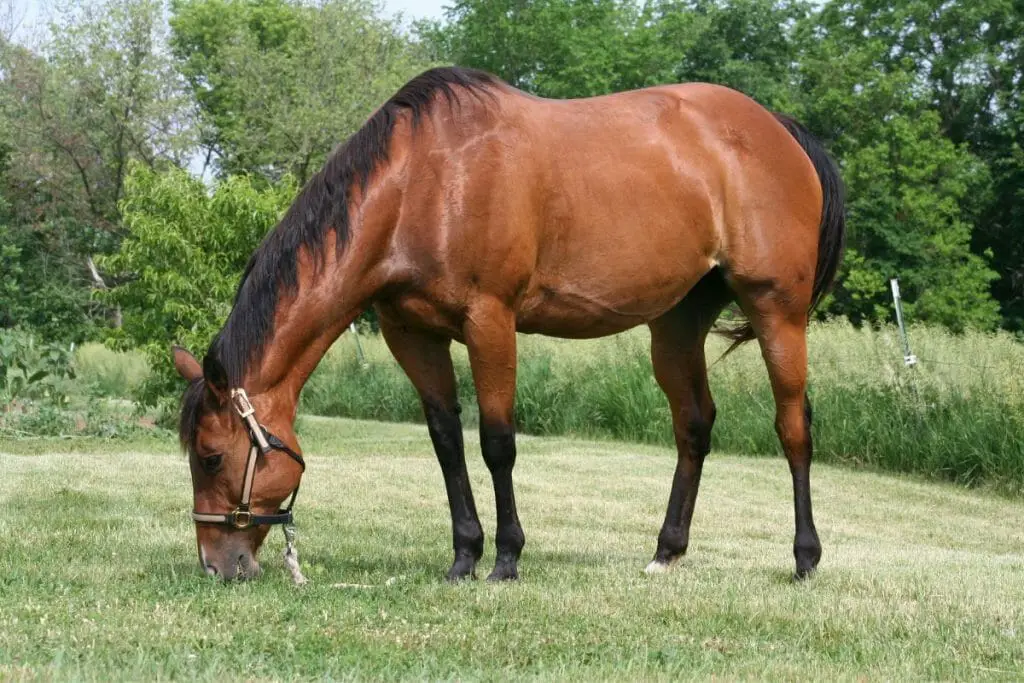
Standard Bay
This is the color that comes to mind when you think of a bay horse. The typical bay horse coat has a reddish-brown coat with black points. It has no hair that stands out as being lighter or darker and the coat color is pretty consistent.
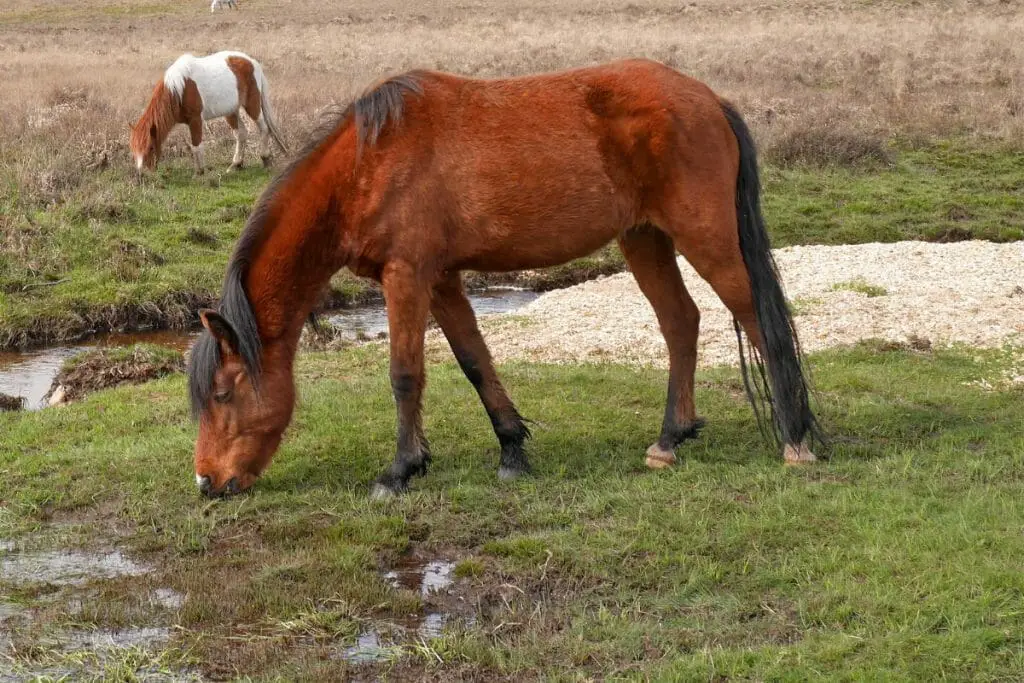
Wild Bay
Wild bays are the shades that have the least amount of black point color. The manes and tails of wild bays are black, but the black points only go up to the pastern or fetlock. Wild bay is sometimes found with a trait called “Pangare,” which gives the underbelly and soft areas, like the area around the stifle and the nose, a pale color.
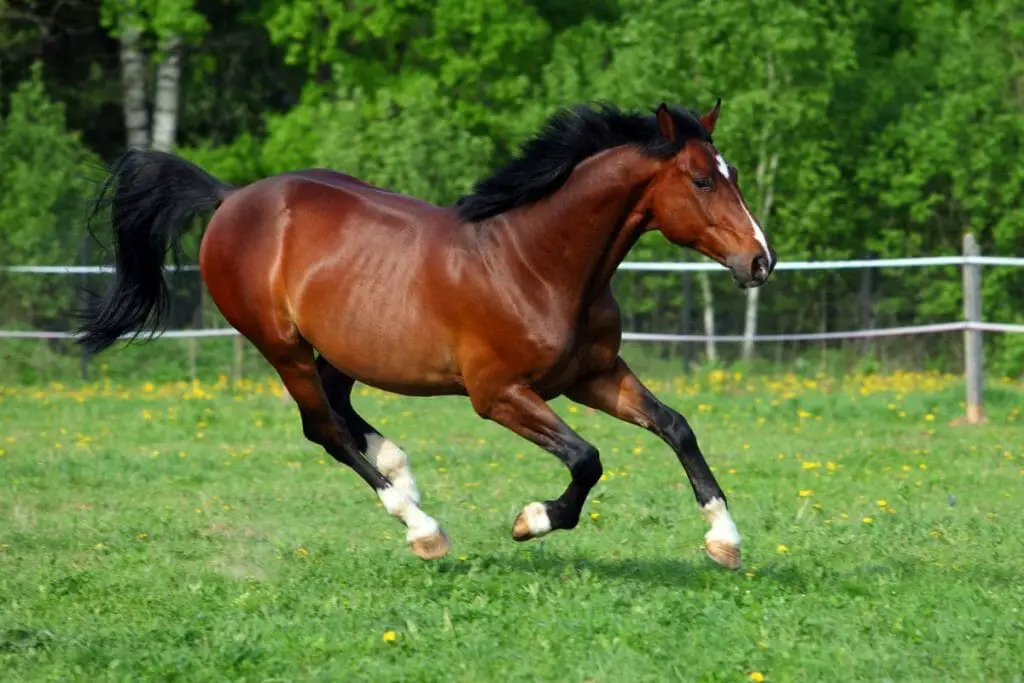
Blood Bay Horse
Blood bay is a darker, more intense version of the color bay. The word “blood” in the name refers to the color of the horse’s coat, which is often a deep red color.
Blood bay horses are often very striking animals, and they can be very beautiful. They are also relatively rare, which can make them even more desirable to horse lovers.
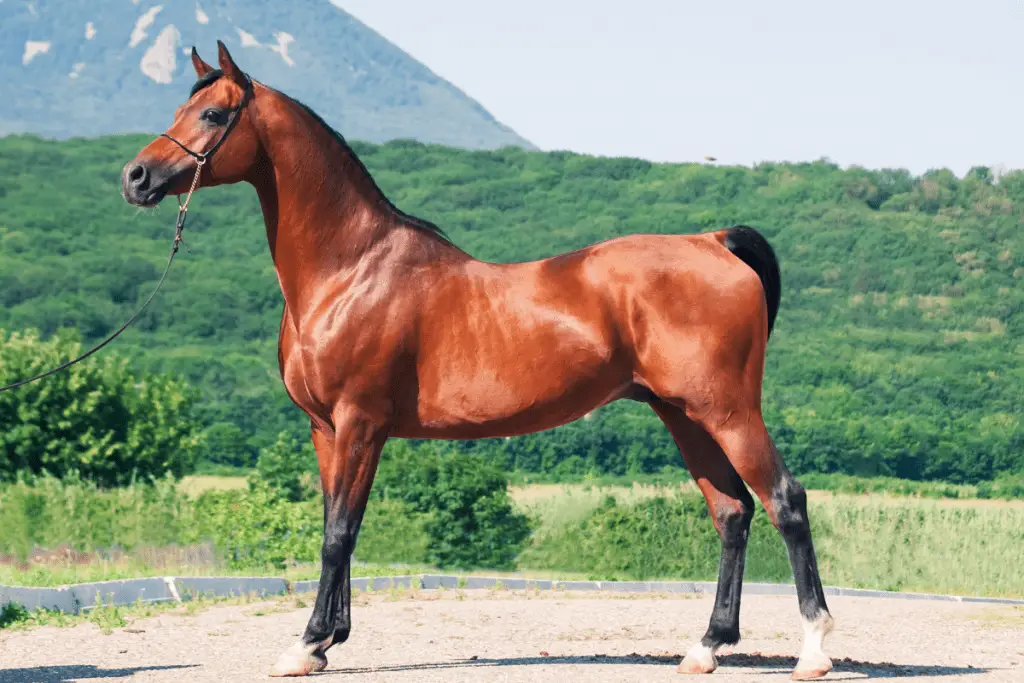
Cherry Bay
Cherry bay is another name people sometimes use for a blood bay. Although some say Cherry bay is a lighter color red than blood bay but just as vibrant and bright.
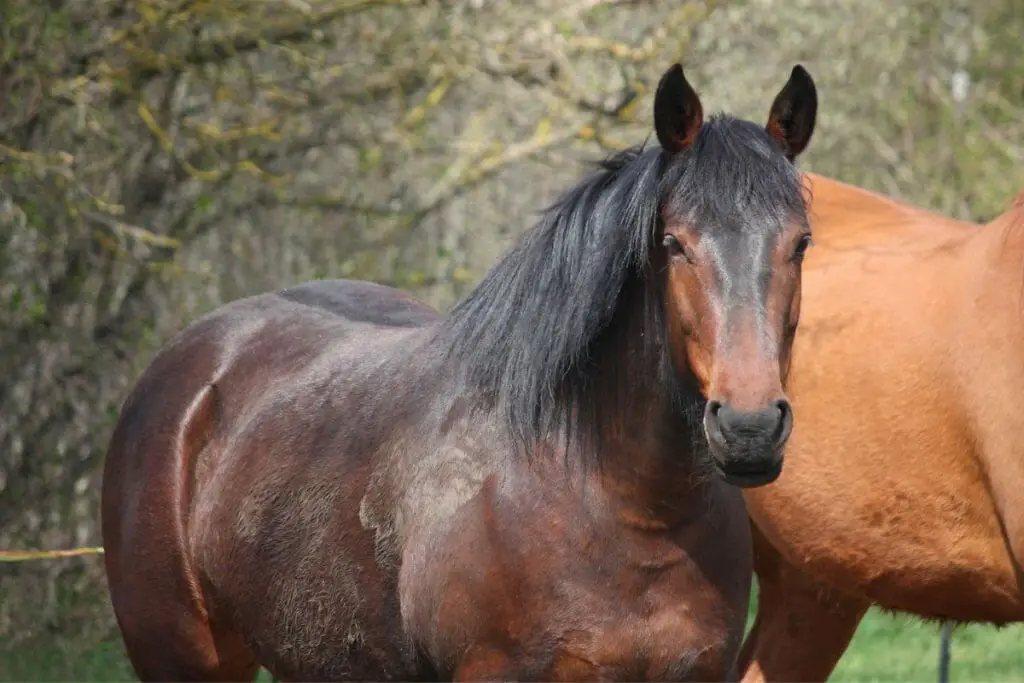
Mahogany Bay
Mahogany bay is similar to blood bay and cherry bay, but darker in color and sometimes has a purplish type of hue to the coat. Mahogany horses can sometimes be referred to as a dark bay.
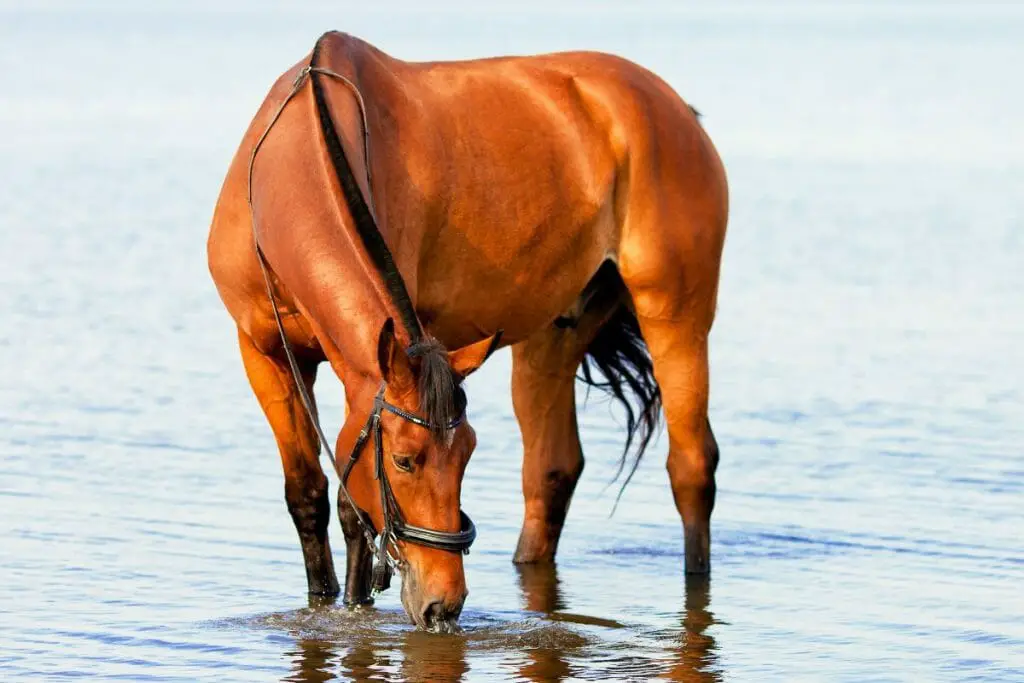
Copper Bay
Most of the time, these horses are also called standard bay horses. But compared to the actual standard bay color, this one tends to be brighter, like a copper penny. Copper-colored horses have a rich, orange-red coat.
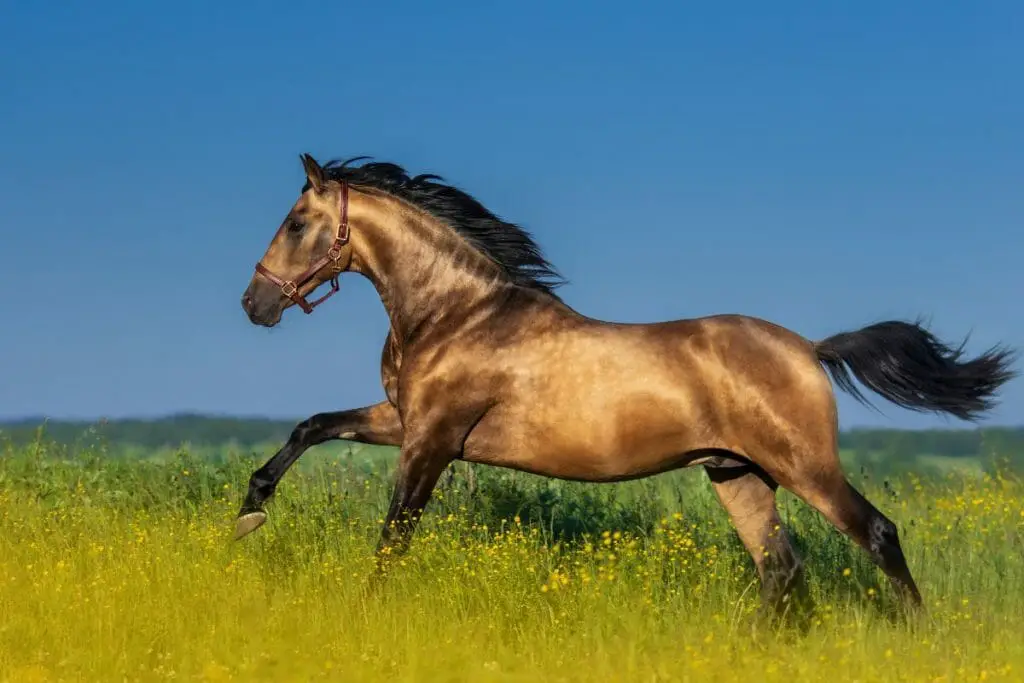
Golden Bay Horse Color and Light Bay
Light bay, also called golden bay, is the lightest shade of bay. It is less common than the darker shades.
The horse’s coat can be anywhere from a light red to a golden yellow. You can mistake them for sandy, buckskin, or dun horses.
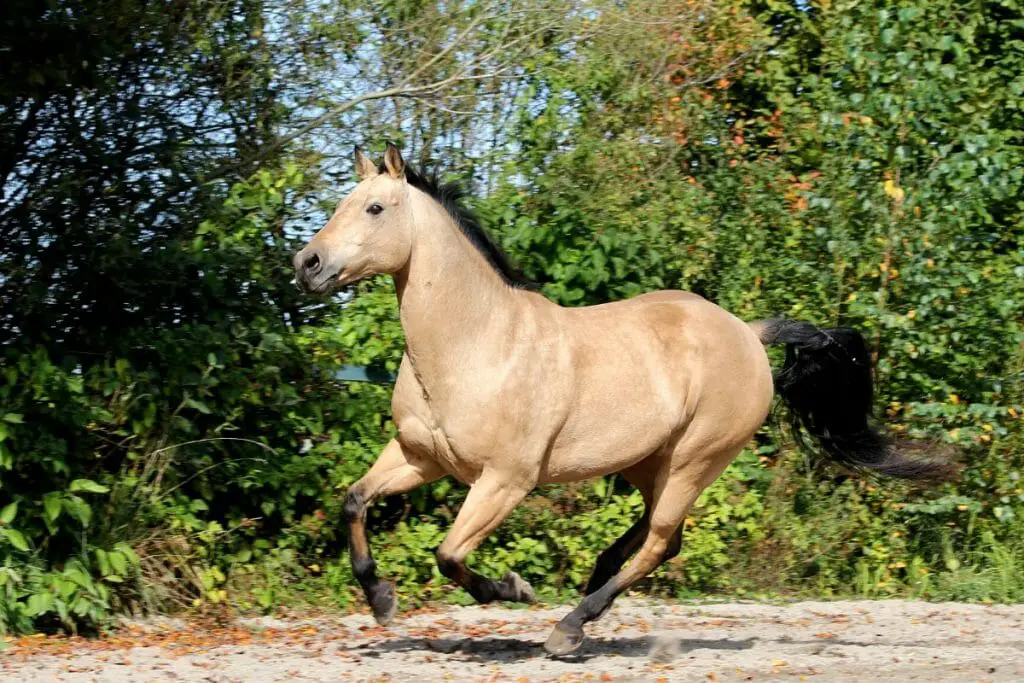
Sandy Bay
Even though a “Sandy” bay was once called that in older books about horse colors, the cream gene creates a genetic difference. Sandy bay is actually buckskin , which is not a bay color but has a bay template with a dominant cream (CCr) allele.
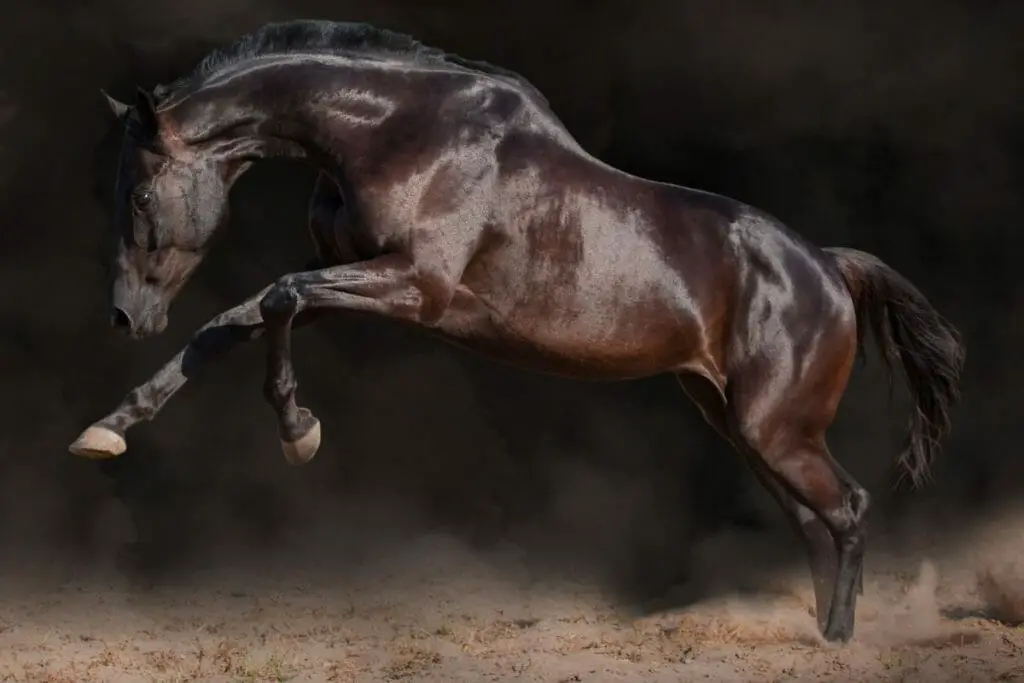
Dark Bay Horses
The term “dark bay” is a bit ambiguous and refers to bays with darker shades of color. It can refer to dark bay, mahogany bay, black-bay, or brown (or “seal brown”). Dark bays can be so dark that they almost look black but still have some brown bay hairs mixed in. These are called black bays. A true black horse would have all black hairs.
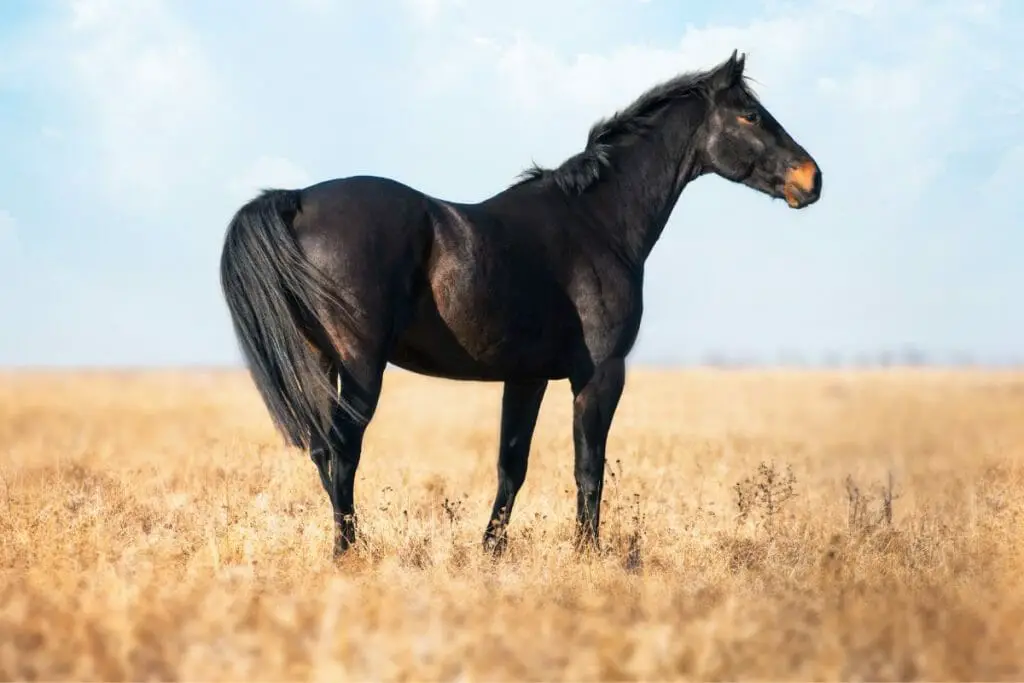
Seal Bay Horses
A dark bay color. Seal browns often have coats that are almost black, with brownish-red hairs only showing under the eyes, around the muzzle, behind the elbow, and in front of the stifle.
Dark shades of bay’s genes are still being looked into. The genetic process that makes seal brown hasn’t been found yet.
Seal brown is linked to a certain allele of Agouti. A DNA test was conducted that was supposed to find the seal brown (At) allele. However, the test was never peer-reviewed, and because it gave unreliable results, it was taken off the market.
The Most Common Bay Color Variation
The standard bay color variation is the most typical form of the bay color. It can vary from a reddish brown to a less red color. But the coat is mostly uniform.
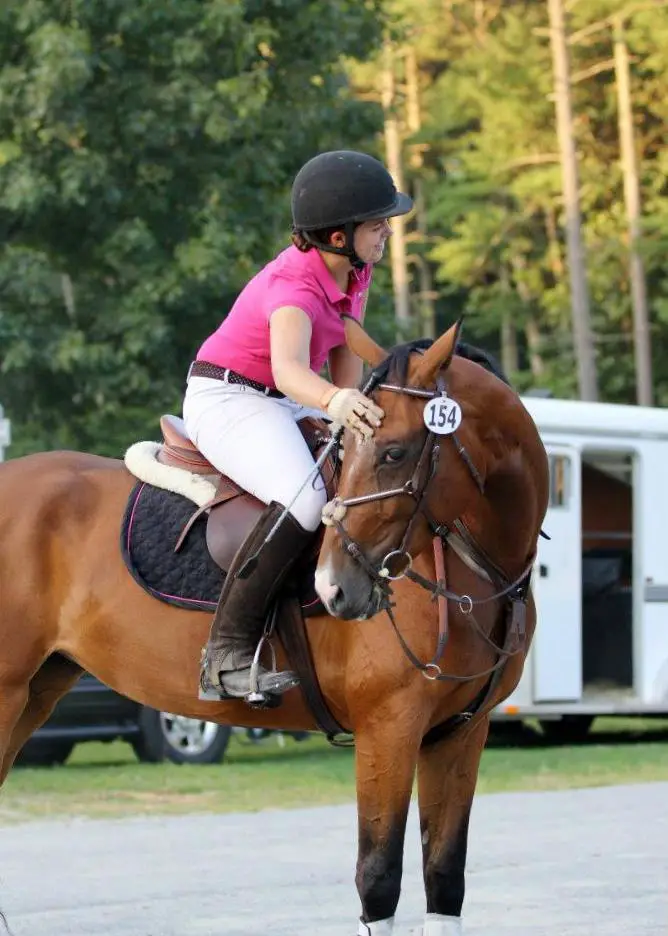
Rarest Bay Color Variation
It is claimed that blood bay is the rarest bay coloration, however, golden bay is also thought to be a rare color.

Horse Colors Often Confused With Bay
Due to their similar looks and shades of coat color, bay horses are often mistaken for other colors of horses.
Here are some coat colors that people often mistake for bay:
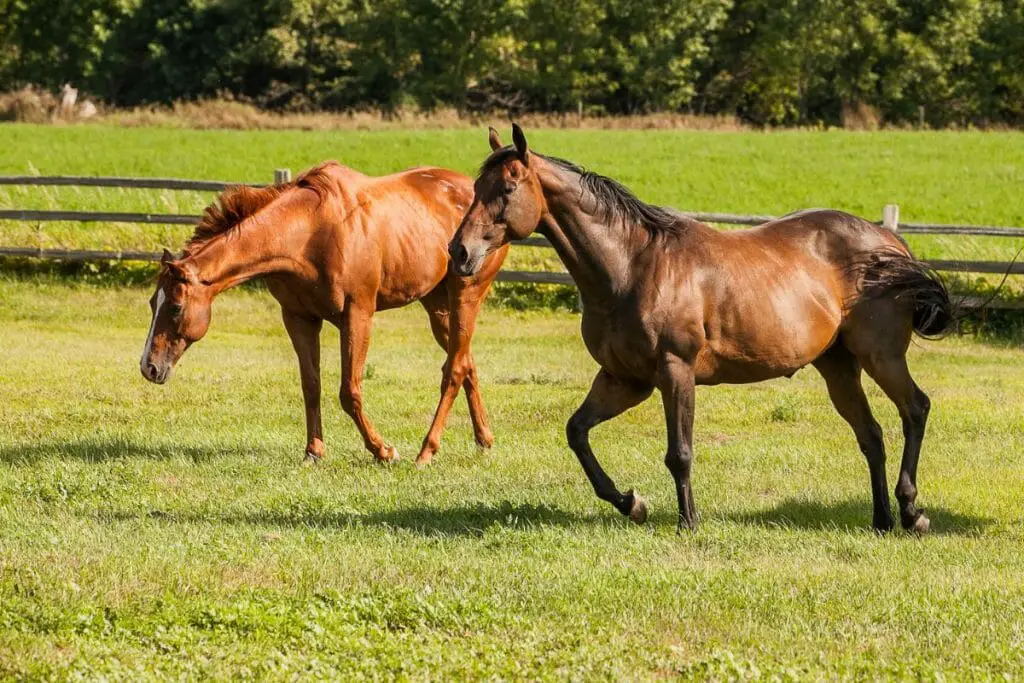
Chestnut or Sorrel
Chestnut horses resemble bay horses because of their reddish body color.
However, they don’t have black points and their manes and tails are the same as their chestnut color or a few shades lighter than their coat. Chestnuts are sometimes referred to as “sorrels.”
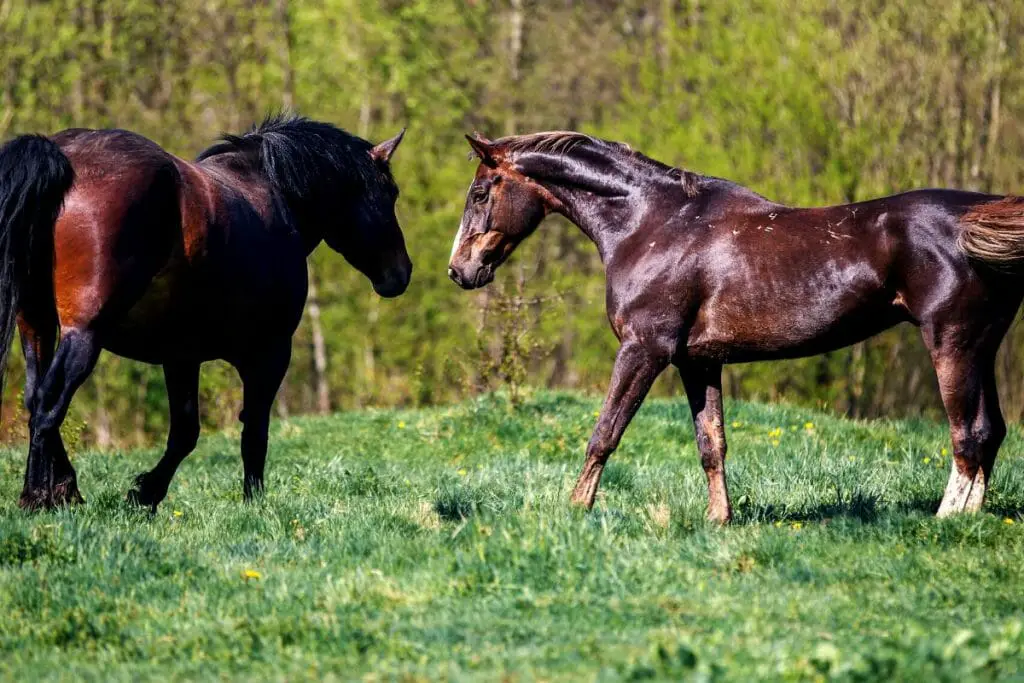
Liver Chestnut
Liver chestnuts, which are also very dark brown, can be confused with dark bay or brown horses, but a liver chestnut has a brown mane, tail, and legs and no black points.
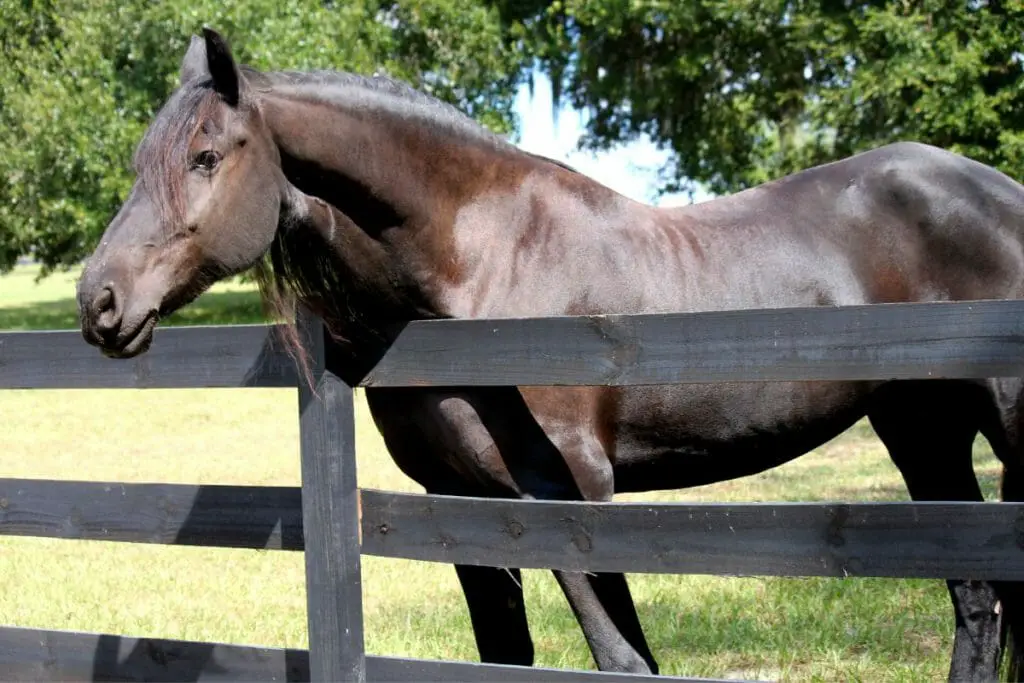
Black
Because of their sunburned appearance when exposed to the sun, black horses are often confused with dark bay and seal brown horses.
Their coat turns a more washed-out brown tone, especially around their flanks.
Also some dark bay and seal brown horses can also appear almost black.
The hair around their eyes and muzzles is a simple way to tell a black horse from a bay horse. On these places, black horses will always have black hairs, whereas bays will have reddish-brown or light gold hairs.
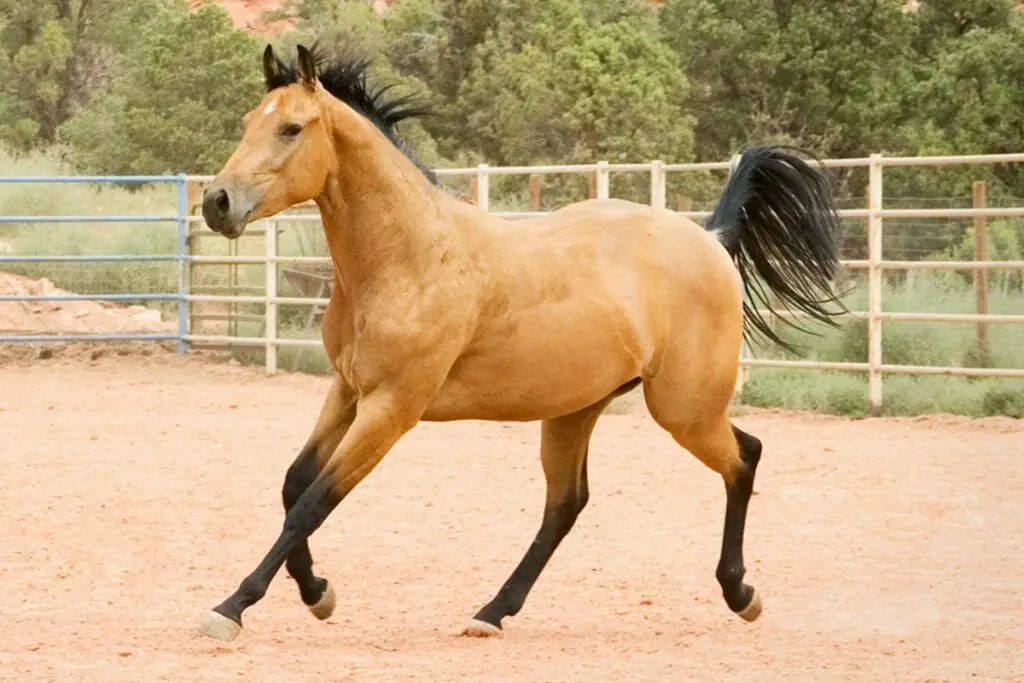
Buckskin
Buckskin is not bay but it does come from bay as a base color. It has a dominant cream allele which dilutes the bay color to a golden yellowish color void of any red hairs.
You can get confused with the buckskin because it also has black points like the bay. And can sometimes look like a golden or light bay.
If you are unsure you will want to do genetic testing to find out.
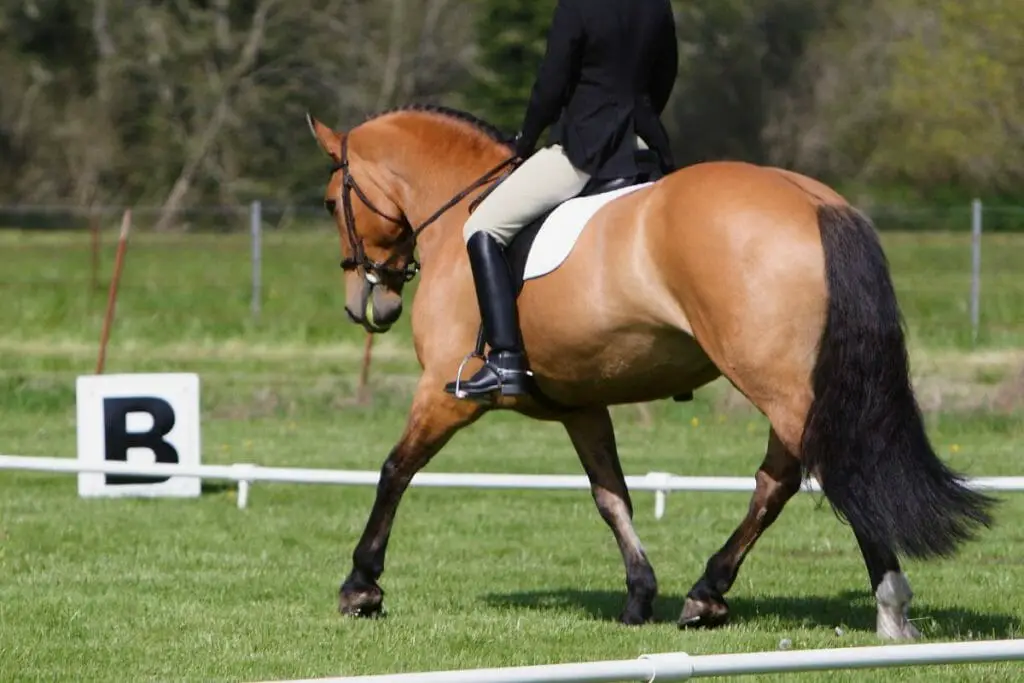
Dun
Dun can be confused with bay the same way that buckskin can be confused. A bay dun can range in shades as well and sometimes a dun can look very similar to a light bay or buckskin color.
A bay dun also has bay as a base with an added dun gene. A dun will have a stripe down the back, wisps of light colored hair in the mane and tail along the base of the mane and tail and can have faint strips on the legs and forehead.
Coat Colors In The Bay-Family
The influence of extra equine coat color genes on a bay base coat template has the effect of transforming the basic color into a variety of colors and patterns.
Chart For Colors In The Bay-Family
| Bay Family Color | Characteristics of Color |
| Sooty Bay | A sooty modifier gene that causes darker areas on bay coat usually around the topline of the horse. A dark bay coloring. |
| Pangaré Bay | Pangaré is a modifier gene that lighten hairs around the legs, belly, muzzle and can lighten the whole coat color as well. |
| Buckskin | The cream dilution gene lightens the red parts of the coat to a yellow or golden color. |
| Perlino | Two cream alleles on a bay has a creamy pinkish or reddish hue similar to the cremello. The skin is a pinkish and the black turns to a brownish color sometimes lighter similar to the rest of the coat. |
| Silver Bay | The Silver dilution gene causes a dappling affect under the coat and turns the black mane and tail into a white silvertype color. Other black points can become more diluted and look browner. |
| Bay Dun | Dun dilution gene on a bay lightens the coat to a yellow similar to buckskin., but the bay dun will have primitive markings along with the color. |
| Bay Roan | These horses are typical bays. This shade, though, is brighter, like a copper penny. Copper-colored horses have orange-red coats. |
| Rose Grey | A pinkish reddish grey coloring caused by a bay horse turning grey from the grey modifier gene. This is typical in the younger years of the horse, but the foal is born bay to start. |
| Bay Pinto | The coat consists of large and small patches of white on a bay base. |
| Bay Leopard | Spotted pattern on a bay base. Bay horses tend to have a pattern that looks like a spotted blanket. |
| Bay Rabicano | Rabicano, sometimes called white ticking, is a horse coat color defined by restricted roaning in a particular pattern: its most simplest form is shown by white hairs at the tip of a horse’s tail, then at the flank, then other regions of the body. |
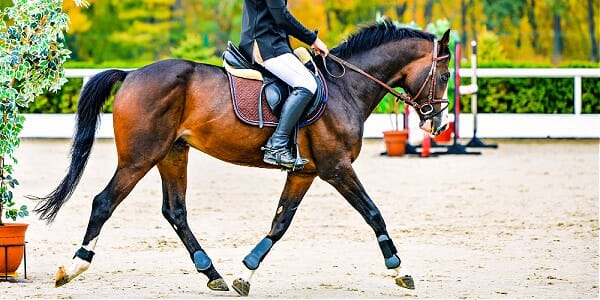
Sooty Bay
Bay + Sooty= Sooty Bay
Sooty is a modifier gene.
Many dark bays are caused by the sooty gene. Horses that don’t have any sooty traits on them are called “clear-coated.”
Sooty is probably in every breed of horse, and many horses show some signs of it.
Bay horses with the Sooty trait have dark hairs and spots on the top of their bodies. This dark topline may look like a rather broad dorsal stripe, as is seen in dun horses.
This is called “countershading,” because the parts of the horse that should get lighter because of the sun are instead darkened. It is thought that this will throw off predators.
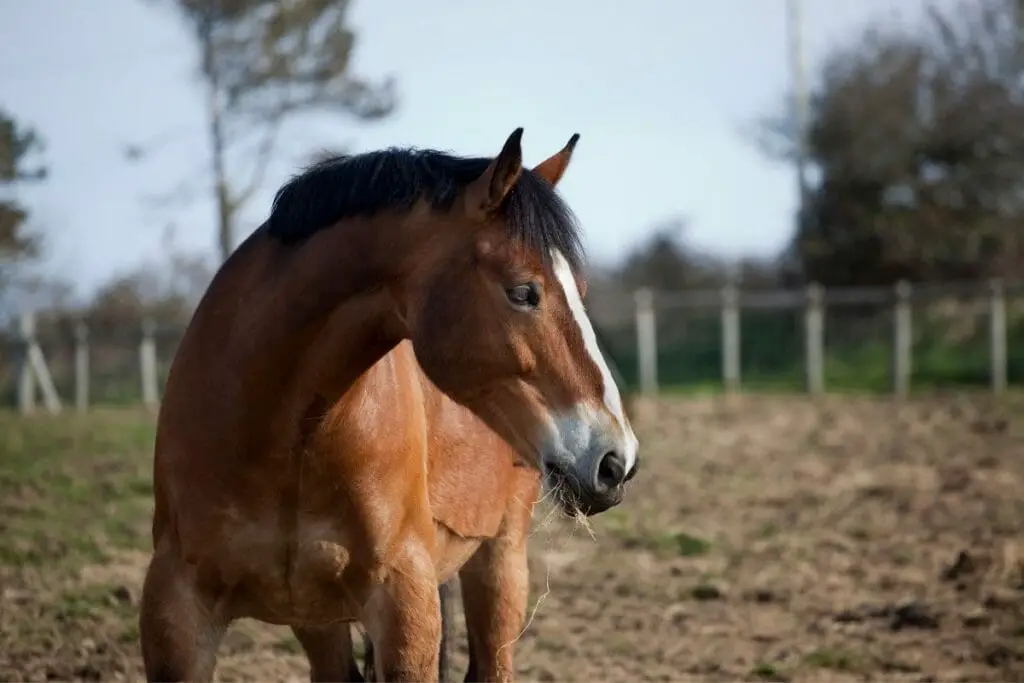
Pangaré Bay Horse Color
Bay + Pangaré= Pangaré Bay
Pangaré is a modifier gene.
Pangaré, also called the “mealy effect,” is common in draft horses and ponies, but it is much less common in sport horses. It can be seen on bay and chestnut horses and the mealy affect is also seen in donkeys, but it may be caused by a different set of genes.
It remains unclear clear if Pangaré is caused by one gene or more, or if it is a recessive trait or a dominant trait.
Usually, it makes the area above the muzzle, the sides, and the belly lighter, but it can also make the whole coat lighter. It might have started out as a way to blend in with the background.
The genes for Pangaré are still not known, and there is no genetic test for it.
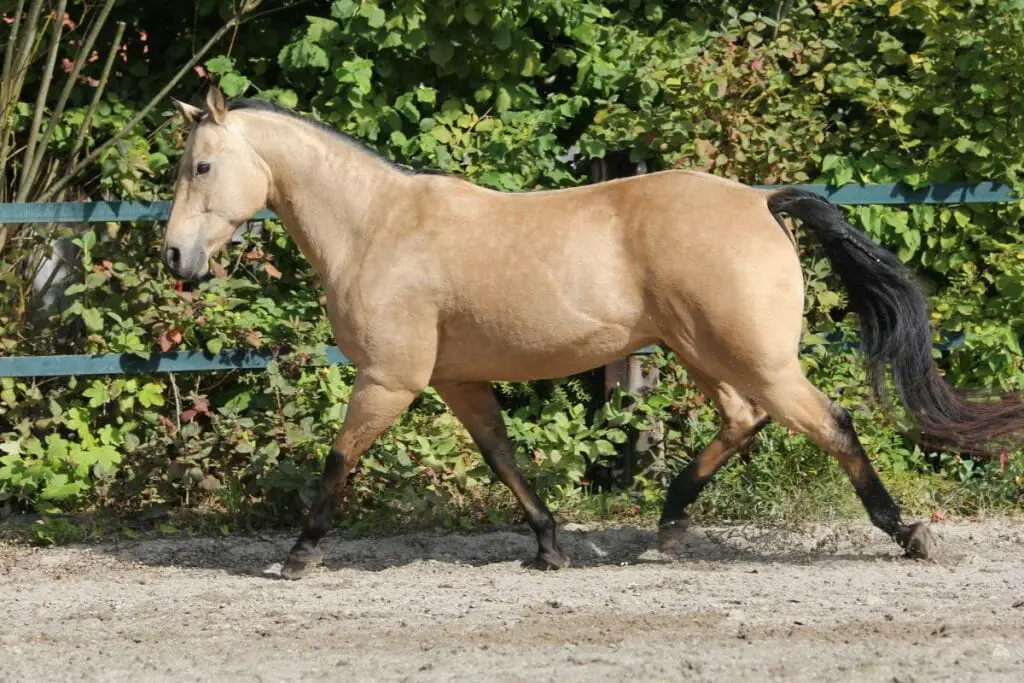
Buckskin Horse Color
Bay + Cream= Buckskin
Cream is a dilution gene.
A buckskin horse is made when a single copy of the cream allele, either CR or CCR, is mixed with a bay horse. The red bay’s coat turns yellow or gold, but the points (the mane, tail, lower legs, and ear tips) stay dark.
If the horse’s coat is seal brown, the coat will get a lot darker. The hairs range in color from yellow to almost black. The hairs on the belly and nose are the lightest. This color is also called brown buckskin or smoky buckskin.
When there aren’t many yellow hairs, it looks a lot like a standard brown color.
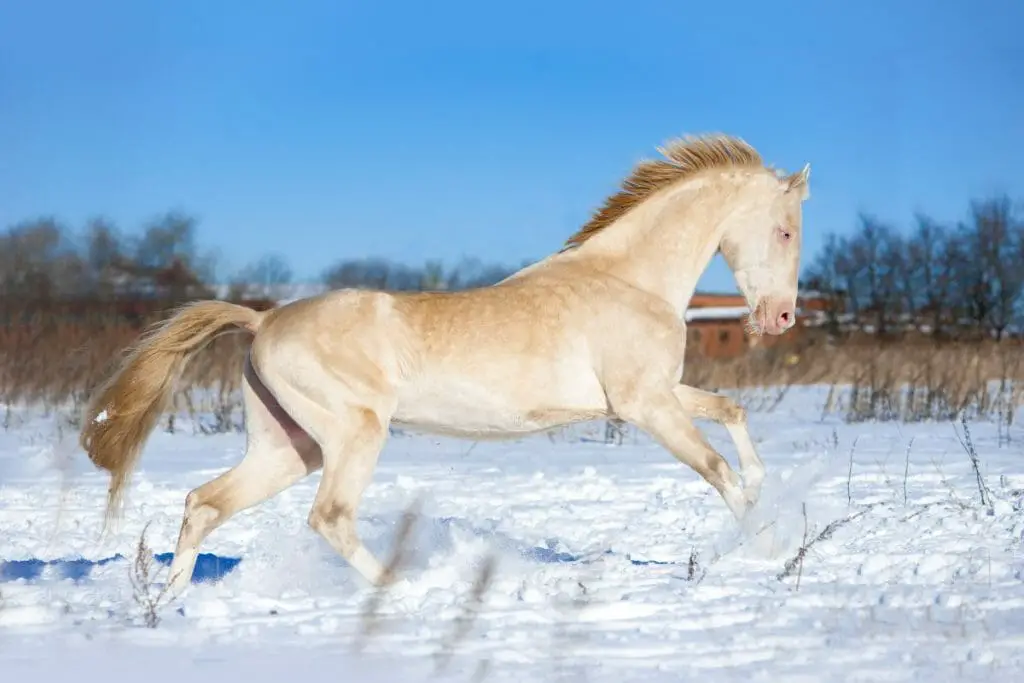
Perlino Horse Color
Bay+ 2 Cream= Perlino
Perlino has a double cream dilution.
It has a light, creamy coat, just like a cremello. The two cream alleles are to blame for this. Most of the time, though, the mane and tail are darker than the body and have a more reddish color.
There are, however, perlinos with hairs so light and long that they can’t be seen. Like a cremello, a perlino’s skin turns pink and its eyes are a light blue color.
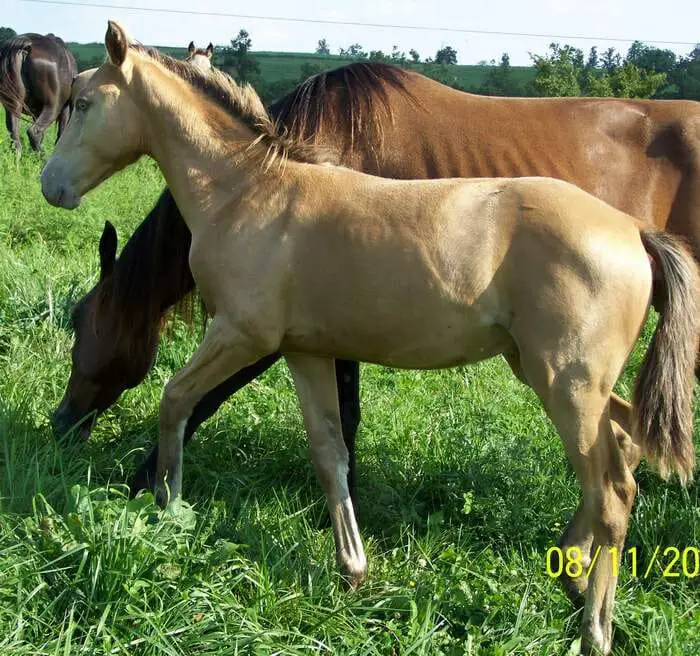
Amber Champagne Horse Color
Bay+ Champagne= Amber Champagne
Champagne is a dilution gene.
A gold champagne looks like it was made by diluting the red coat of a bay horse to a metallic golden shade, but the mane, tail, and legs of the horse remain the typical champagne’s chocolate brown. There may not be much difference between the legs and the rest of the body. In fact, the brown may be almost nonexistent on the legs.
Amber champagnes look a lot like buckskins, but the skin on a buckskin is dark, while the skin on an amber champagne is more of a light pink. The coat also has a more metallic sheen.
The seal brown form is known as sable champagne, and it may be difficult to differentiate from amber and classic champagne.
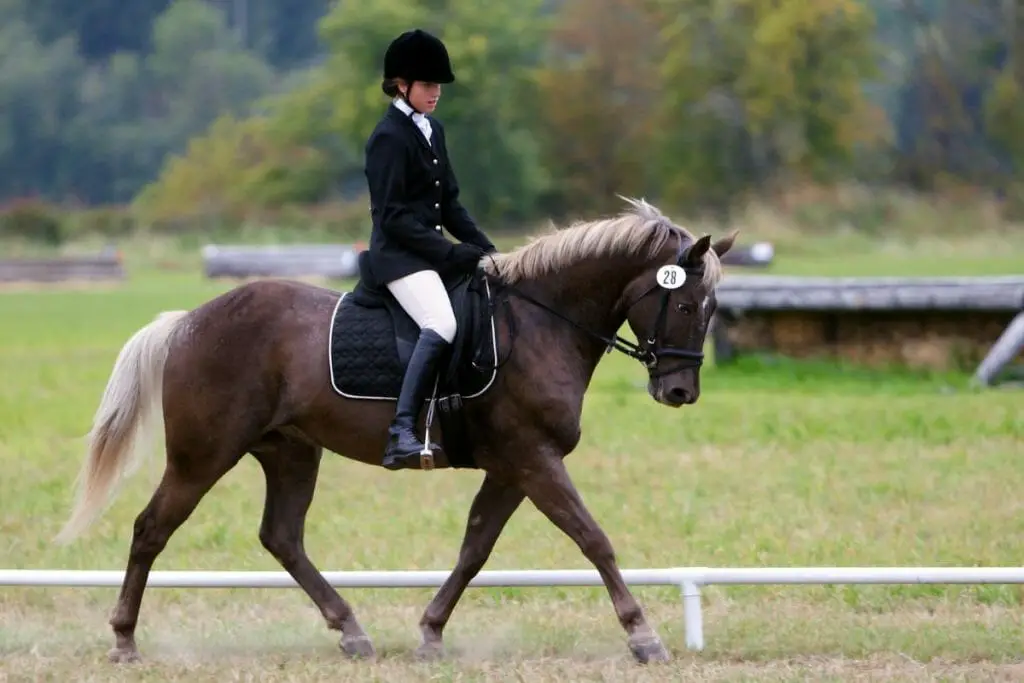
Silver Bay Horse Color
Bay+ Silver= Silver Bay or Silver Seal Brown
The silver dilution is not a well known dilution, yet it has been seen in a handful of breeds.
It is a common trait in the Rocky Mountain Horse for example. The popular name is silver or silver dapple, abbreviated as Z. Other terms used with Silver horses include “Taffy” and “Chocolate.”
The manes and tails of black and bay horses are diluted by silver. It may also have an impact on the lower leg’s black, occasionally diluting it or causing diluted regions. The impression is frequently more pronounced in younger horses since the mane and tail darken with age, often to the point where they look nearly unadulterated.
Silver foals have striped hooves and white eye lashes, however these traits may fade as the horse grows older. Both may be created by other colors, therefore existence is not proof in and of itself.
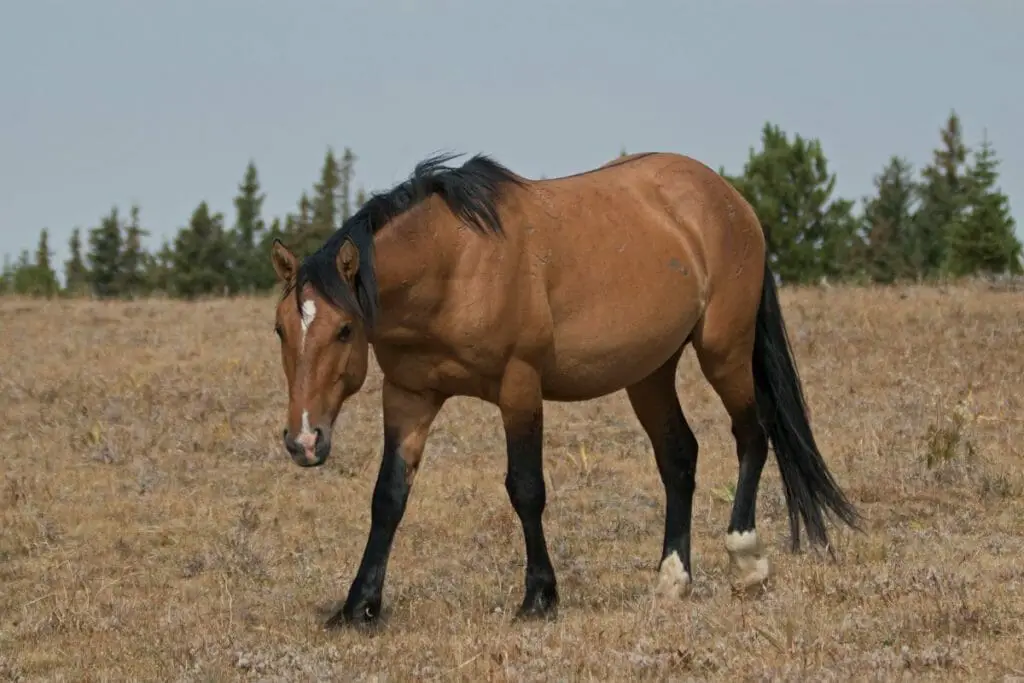
Bay Dun
Bay+ Dun= Bay Dun
Dun is a dilution gene.
Brunblakk is the Norwegian term for bay dun, and is the most common color in the fjord horse.
Bay dun, is often confused with red dun, as well as the buckskin color.
Dun is likely one of the oldest dilutions, since many people think it was the first color of horses. It dilutes the red and black pigment, but it doesn’t change everything.
This is what causes the so-called “primitive markings,”:
- dorsal stripe
- leg barring
- shoulder and sometimes neck stripes or shadows
- darker ear tips
- frosting in the mane and tail
- a dark face mask
- mottling on the upper leg
- cobwebs on the forehead
- brindling
The horse doesn’t always have all of these at the same time. Also, the coat is made a little bit lighter and less bright, which makes the darker markings stand out more.
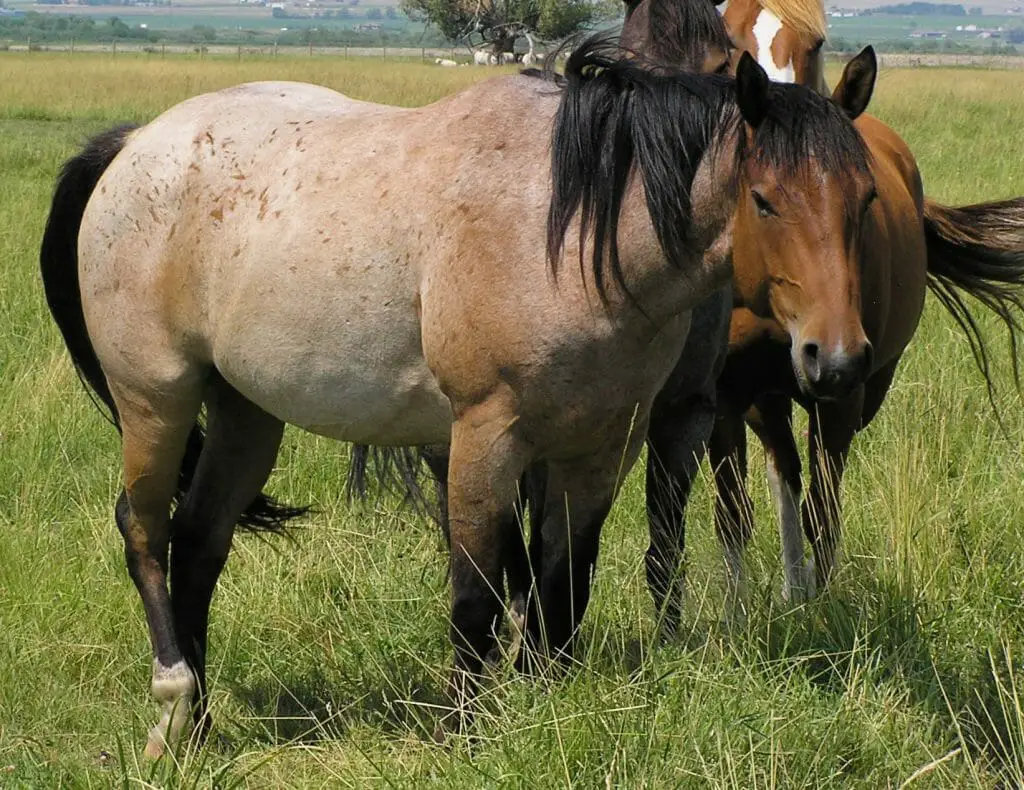
Bay Roan Horse Color
Bay+ Roan= Bay Roan
Roan is a white pattern gene.
The body of a roan horse has an even mix of colored and white hairs, while the head, lower legs , mane, and tail (called “points”) are mostly one solid color.
The color of a bay roan horse’s coat is bay mixed with white hairs in an even way. There are a little to no white hairs on the head, legs, mane, and tail.
The roan pattern is passed down by dominant inheritance and can be found in many breeds of horse. True roan is always there when a foal is born, but it may not be easy to see until the foal is older.
Roan is known as a dominant trait represented by the Rn allele. Dominantly inherited traits are handed down to each generation, which means that two non-roan parents cannot create roan offspring.
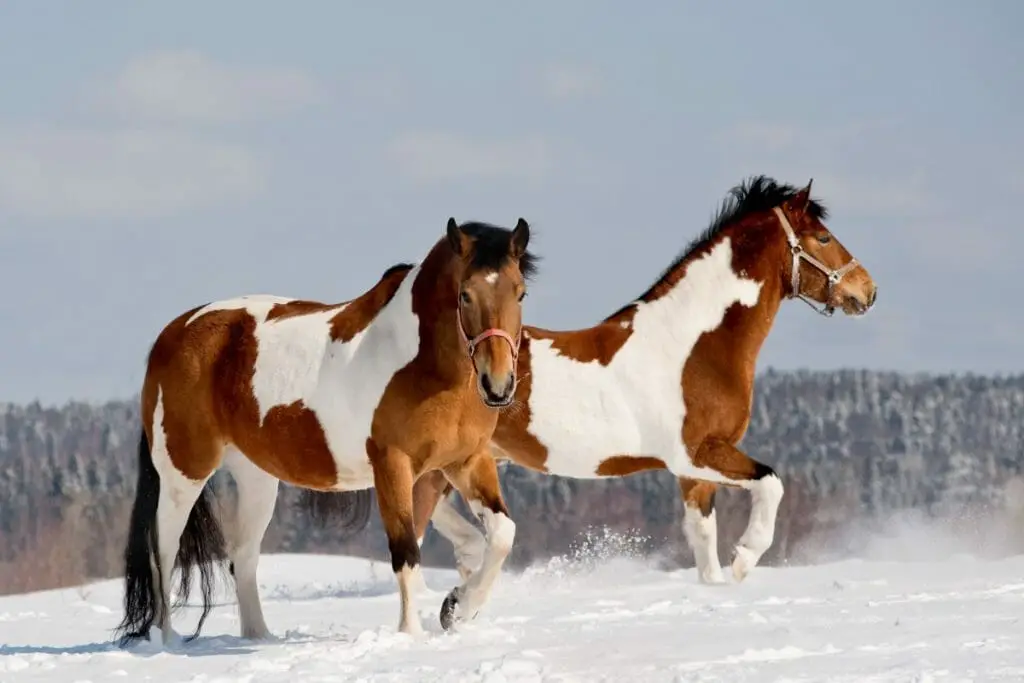
Bay Pinto
Bay+ Pinto= Bay Pinto
Pinto is a white pattern gene.
Bay pintos are bay horses that have one or more white-spot genes, such as tobiano, frame overo, splashed white, and so on. The pattern has nothing to do with if the horse is bay or not. Pinto horses can also have a base coat color of bay with white spots on top. People sometimes call bay pintos “skewbald” or “tricolor.”
Even though sabino is a pinto color pattern, certain horses with highly pronounced white markings or mild body spotting may be classified as “bay” by their owners, especially in breed registries that do not offer a category for pinto.
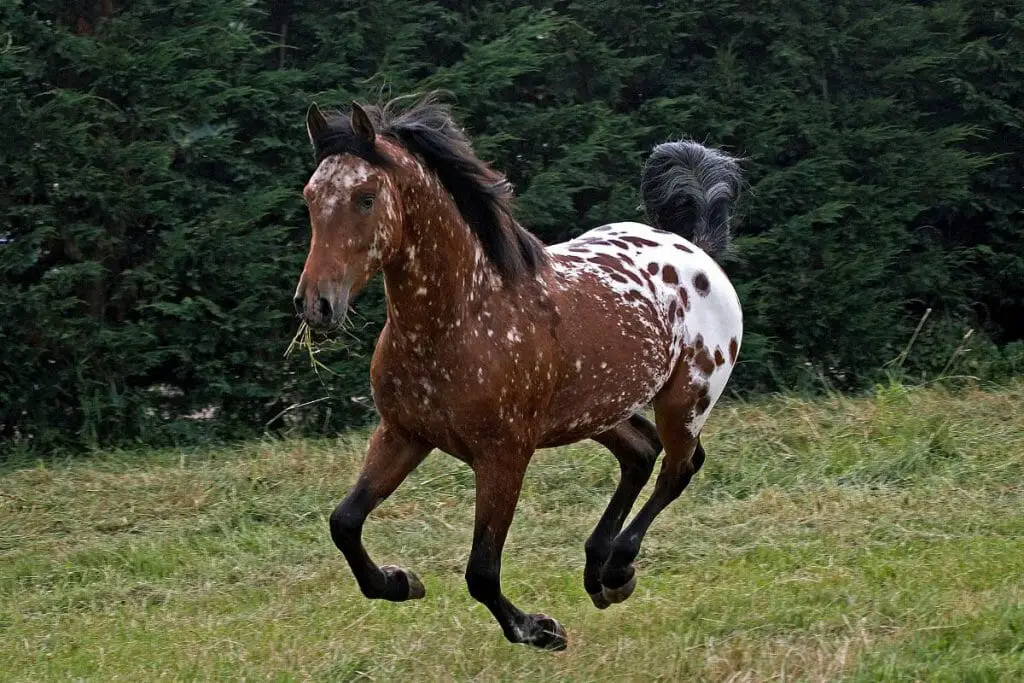
Bay Leopard
Bay+ Leopard= Bay Leopard
Leopard is a white pattern gene.
The leopard (Lp) gene or gene complex, found in Appaloosas and other horse breeds, is also present in Bay Leopards. As a result, this gene creates a spotted coat, white eye sclera, and striped hooves.
Bay Rabicano
Check out this image of a Bay Rabicano.
Bay+ Rabicano = Bay Rabicano
Rabicano is a white pattern gene.
Some bay horses may have the rabicano gene, which makes some parts of the body have a faint roan or makes some white or cream hairs grow in the mane or tail, giving the horse a “skunk” look. Most rabicano-carrying bays are classified as bays or bay roans.
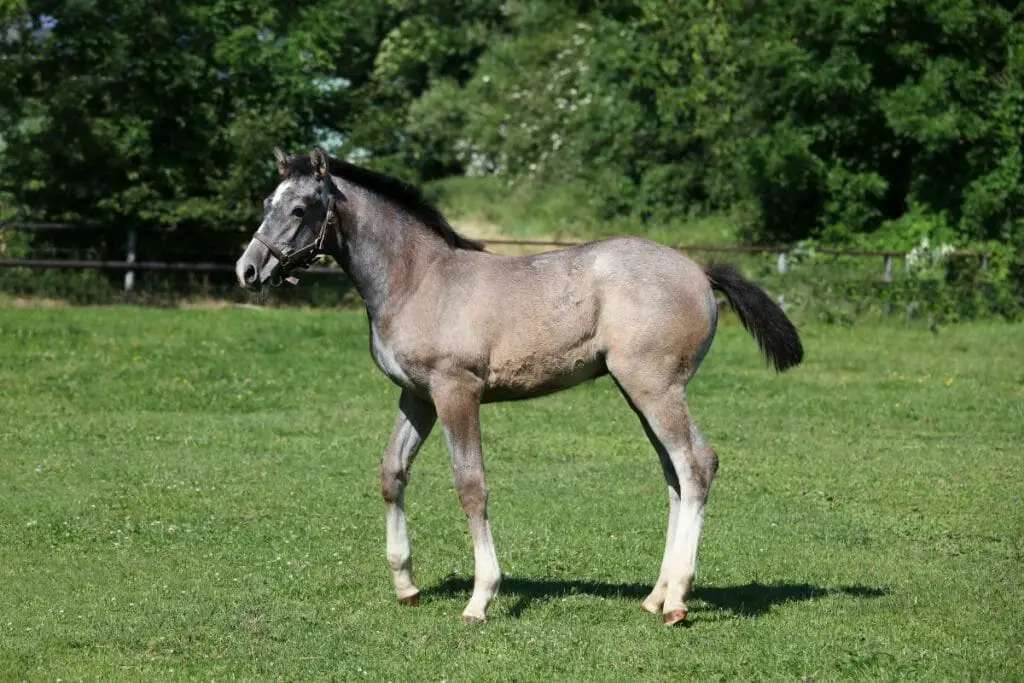
Rose Grey Horse Color
Bay+ Grey= Rose Grey & Eventually Full White Grey
Grey is a modifier gene.
A bay horse with the grey modifier will be born bay and start to lighten as they get older. White hairs will begin to intersperse through the coat. This can happen faster or slower depending on the horse.
Sometimes grey horses can be confused with roans when they are younger and growing more white hairs.
However a roan is born with the peppered coloring , where as a grey begins to develop the white hairs as they grow. A bay horse with the grey gene ends up having a rose grey color until their coat begins to white out. The coat will look to have a pinkish or reddish tint to it.
When the horse gets older, their coat will eventually be white or even flea-bitten. Although flea-bitten horses typically come from a chestnut base coat.
Bay Horses In Different Horse Breeds
There are many horse breeds that come in the color bay. In some breeds, bay is a very common color more so than other breeds. There’s even a breed of horse that is exclusively bay. There are also a small few horse breeds that don’t come in the color bay at all.
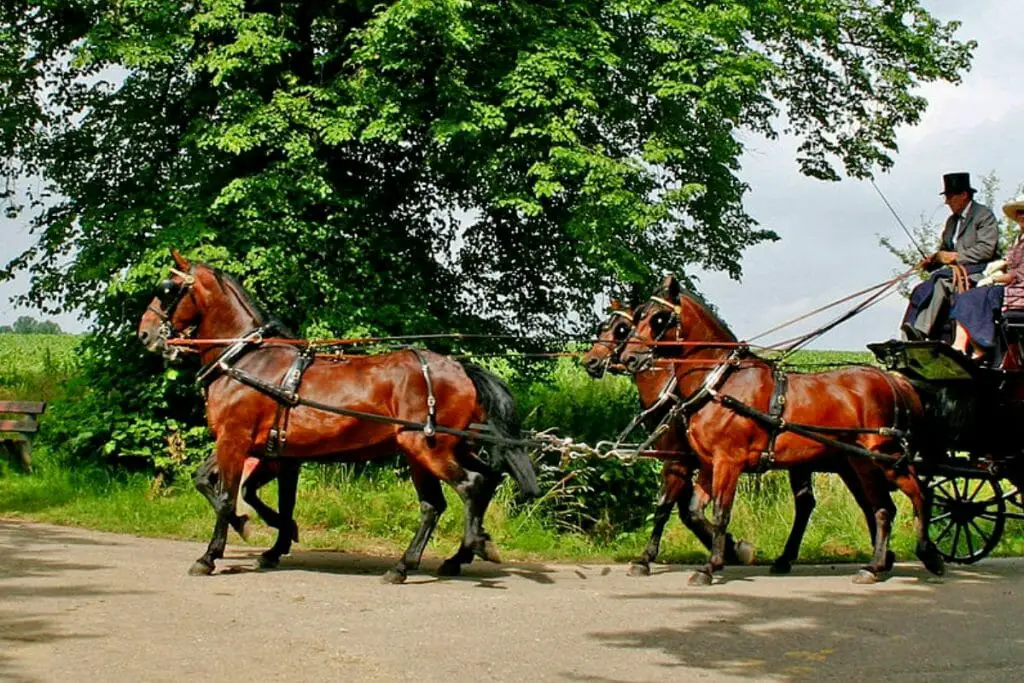
Horse Breed That’s Exclusively Bay
The Cleveland Bay is a horse breed that is exclusively bay in color. The breed is named after the English city of Cleveland, in the North Riding of Yorkshire, where it originated.
The Cleveland Bay is a versatile breed that is used for a variety of purposes, including show jumping, dressage, and eventing. The breed is known for its athleticism, intelligence, and good temperament.
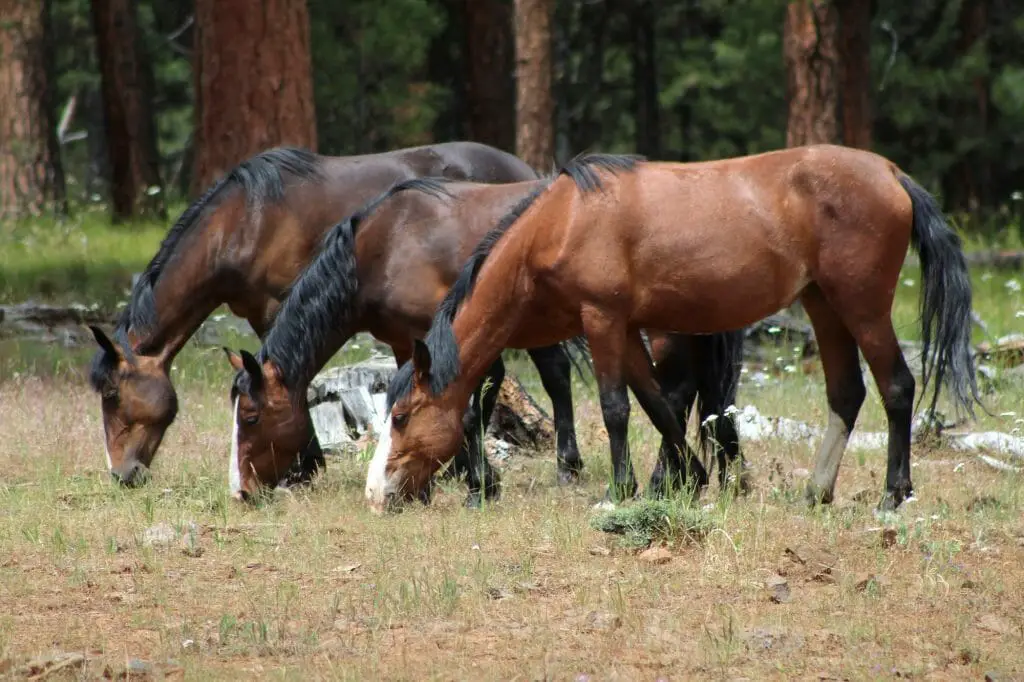
Horse Breeds That Come In Bay
- Akhal Teke Horse
Andalusian Horse
Appendix Quarter Horse
Arabian Horse
Ardennes Horse
Arenberg-Nordkirchener Pony
Argentine Anglo
Australian Pony
Australian Stock Horse
Baguales Horse
Bashkir Horse
Bhirum Pony
Black Forest Horse
Blazer Horse
Bose Pony
Breton Horse
Budyonny Horse
Byelorussian Harness Horse
Canadian Horse
Canadian Sport Horse
Carolina Marsh Tacky Horse
Cleveland Bay Horse
Coffin Bay Pony
Comtois Horse
Criollo Horse
Dales Pony
Danish Sport Pony
Danish Warmblood Horse
Dartmoor Pony
Dartmoor Pony
Dongola Horse
- Dutch Draft Horse
Dutch Warmblood Horse
Exmoor Pony
Falabella Horse
Faroe Pony
Fell Pony
Fouta Horse
French Saddle Pony
French Trotter Horse
Gayoe Pony
German Riding Pony
Gotland Pony
Guizhou Pony
Hanoverian Horse
Holsteiner Horse
Hucul Pony
Indian Half-Bred
Kabarda Horse
Karabakh Horse
Kerry Bog Pony
Knabstrupper Horse
Landais Pony
Lipizzan Horse
Lokai Horse
Manipuri Pony
Mongolian Horse
Namib Desert Horse
Newfoundland Pony
Nokota Horse
Nonius Horse
Norman Cob Horse
Oldenburg Horse
- Percheron draft Horse
Persano Horse
Peruvian Paso
Poney du Logone
Pryor Mountain Mustang Horse
Racking Horse
Retuerta Horse
Romanian Sporthorse
Russian Don Horse
Russian Trotter
Samolaco Horse
Sarcidano Horse
Sardinian Anglo-Arab Horse
Shire Horse
South German Coldblood
South German Coldblood
Spanish Mustang Horse
Spanish-Norman Horse
Standardbred Horse
Swiss Warmblood Horse
Tibetan Pony
Tori Horse
Ukrainian Riding Horse
Vlaamperd Horse
Welara Pony
Yili Horse
Zanskari Horse
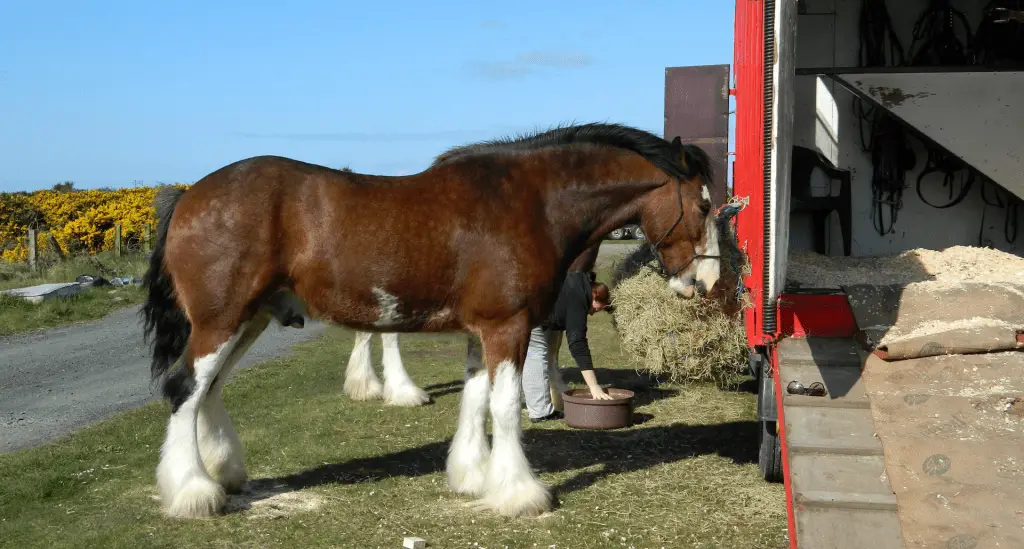
Horse Breeds Where Bay Is A Common Color
These are horse breeds where a bay is the most common color you can find.
- American Quarter Horse
- Andalusian Horse
- Arabian Horse
- Ardennes Horse
- Belgian Draft Horse
- Canadian Horse
- Clydesdale
- Morgan Horse
- Marwari
- Standardbred Horse
- Tennessee Walking Horse
- Thoroughbred
Horse Breeds That Don’t Come In Bay
There are a small few horse breeds that don’t come in the color bay. Here are 3 of them.

Suffolk Punch
Suffolk Punch horses are a beautiful and unique breed that is known for their chestnut or sorrel coloration. They lack the black gene, which is required for the bay color.

Friesian Horses
Friesian horses are a beautiful and regal breed that is mostly black, with very few chestnut-colored horses which are known as Fox Friesians. They do not come in the color bay but if out in the sun a lot it can turn their black coats a brownish color.

Haflinger
The Haflinger is a beautiful horse breed that is dominantly chestnut in color with a flaxen mane and tail. They do not come in the coat color bay.
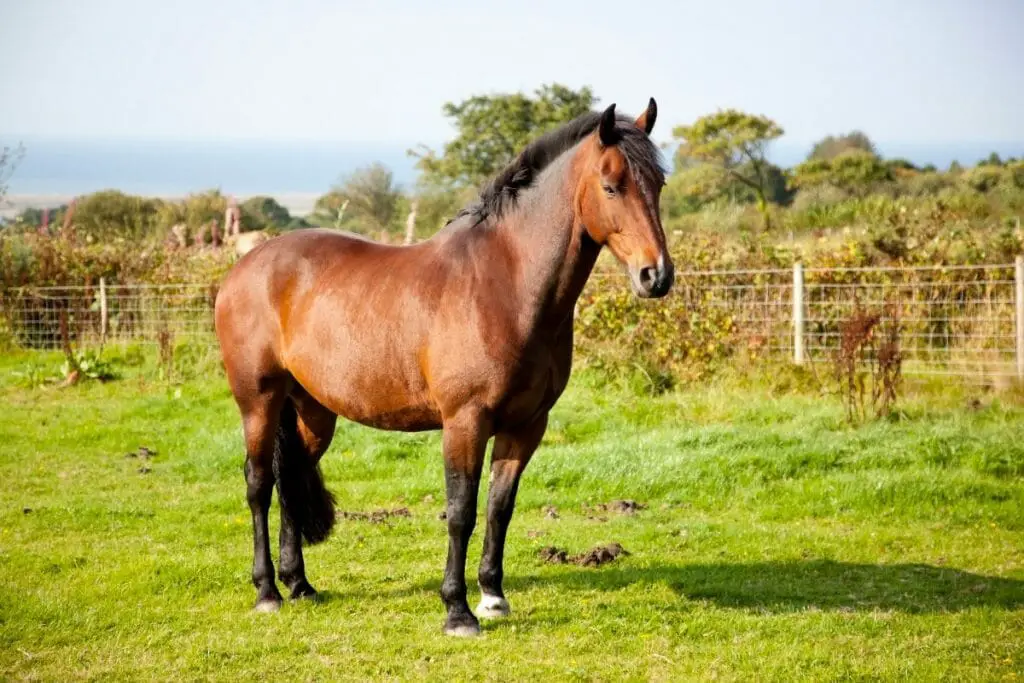
7 Fun Facts About Bay Horses
1. Bay is the most popular horse coat color.
Bay is the most popular horse coat color. They are even considered the standard horse color. A bay horse can be found in practically any discipline, including racing, western and English competition, and pleasure riding.
2. Two basic pigments that make up all the colors of horses.
There are only two basic pigments that make up all the colors of horses, which are red and black. Bay comes from the pigment black, with a dominant Agouti gene pushing back the black to the points of the horse.
3. Bay is one of the three basic types of horse coat colors.
Bay is one of the three basic types of horse coat colors, which are bay, chestnut, and black. They can be thought of as templates to which other genes can be added to make other colors.
4. Dapples on a bay horse indicate good condition.
The pigment of a bay horse’s coat, regardless of hue, is rich and thoroughly saturated. If properly cared for, this makes bays especially glossy in the sun. Some bay horses have dappling, which is created by textured, concentric rings within the coat. Dapples on a bay horse indicate good condition and care, yet many well-cared-for horses never dapple. Dappling may also be genetic.
5. Red areas of a bay coat have a two-toned hair shaft.
Red areas of a bay coat have a two-toned hair shaft, which, if clipped short, may cause the horse to appear many shades lighter, a dull orange-gold, almost like a dun. As the hair grows, it will darken again. This effect is linked to the genetics that creates red coloration in horses, but not in body-clipped darker bays because there is less red in the hair shaft.
6. Bay horses have black skin.
Except for the skin under white markings, which is pink, bay horses have black skin and dark eyes. Knowing this can help you tell the difference between a bay horse with white markings and a horse that looks like a bay but isn’t.
7. Some bay horses can have a faint dorsal stripe.
It is thought that the non-dun 1 allele is responsible for the faint dorsal stripe (line marking from mane to tail) that appears on some bay horses.
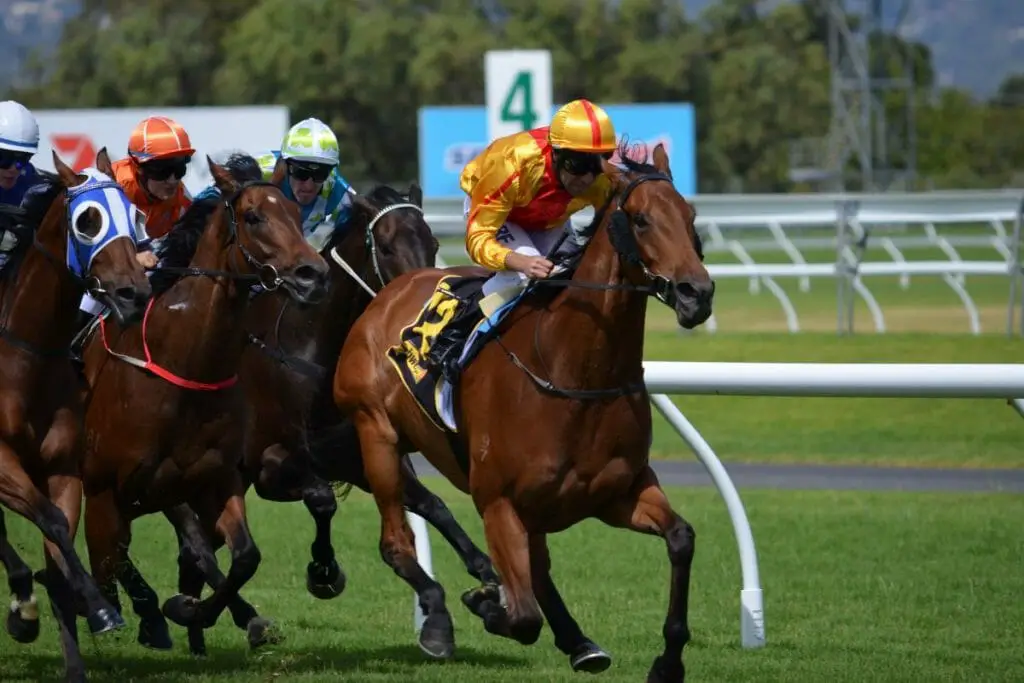
Famous Bay Horses
Here are some bay horses who are famous in history, racing and as sport horses.
Famous Bay Race Horses
- Frankel: Standard bay. Frankel is a former champion British Thoroughbred racehorse who is now a sire. He was undefeated in fourteen races and was the world’s top-rated racehorse in May 2011.
- Storm Cat: Dark bay. His top breeding cost was $500,000, the highest in North America at the time. In 1999 and 2000, he was the top sire in North America, and he was the leading juvenile sire a record seven times.
- War Admiral: Dark bay. He won the American Triple Crown for the fourth time. He was also the 1937 Horse of the Year and well-known as Seabiscuit’s competitor in the 1938 ‘Match Race of the Century.’
- Seabiscuit: Light bay. In the late 1930s, he was a champion. In a match race, he defeated triple crown winner War Admiral and was named Horse of the Year in 1938.
- Northern Dancer: Standard bay. Northern Dancer won the Kentucky Derby and Preakness, but he is best known as the twentieth century’s most successful sire.
- Cigar: Dark bay: Cigar was the world’s most profitable race horse. He was also chosen as Horse of the Year.
- Big Brown: Standard bay: In 2008, Big Brown won the Kentucky Derby and the Preakness. He was named three-year-old champion colt. His only defeat came in the 2008 Belmont Stakes.
- Shergar: Dark bay. At barely 5 years old, this British racing bay was retired to stud, but he was cruelly abducted and held for ransom. In 1999, a film based on the events aired, starring Mickey Rourke.
Famous Bay Sport Horses
- Valegro: Dark bay. This dressage horse has won two World Championships. During his career, the Dutch Warmblood achieved world records in the Grand Prix, Grand Prix Special, and Grand Prix Freestyle, and earned multiple Olympic medals.
- Sam: Standard bay. This remarkable bay was the World, European, and Olympic eventing champion all at once!
Famous Bay Horses In The Movies & TV
- Budweiser Clydesdales. Mahogany bay. Anheuser-Busch used these bay draft horses to commemorate the end of prohibition in 1933. The people loved them, so they started breeding high-quality (always bay) horses for carriages and promotions.
- Popcorn Deelites. Blood bay. One of 40 horses to play the role of Seabiscuit in the movie.
- Finder’s Key. Standard bay. This bay racehorse turned actor, played Joey in War Horse, the famed horse in Seabiscuit and also appeared in Legend of Z.
- Thee Cyclone. Dark bay. This Arabian, portrayed the young Black Stallion in 2003’s. However he had to be dyed black for the role.
Famous Bay Horses In History
- Figure. Dark Bay. Justin Morgan, a singing instructor, was given a sturdy little bay horse to satisfy a debt in 1792. He could outrun and outpull all of the local horses, and he became the Morgan breed’s foundation sire.
- Godolphin Arabian. Bay. Often known as the Godolphin Barb, was an Arabian horse and one of the three stallions responsible for the contemporary Thoroughbred. Francis Godolphin, 2nd Earl of Godolphin, was his most well-known owner.
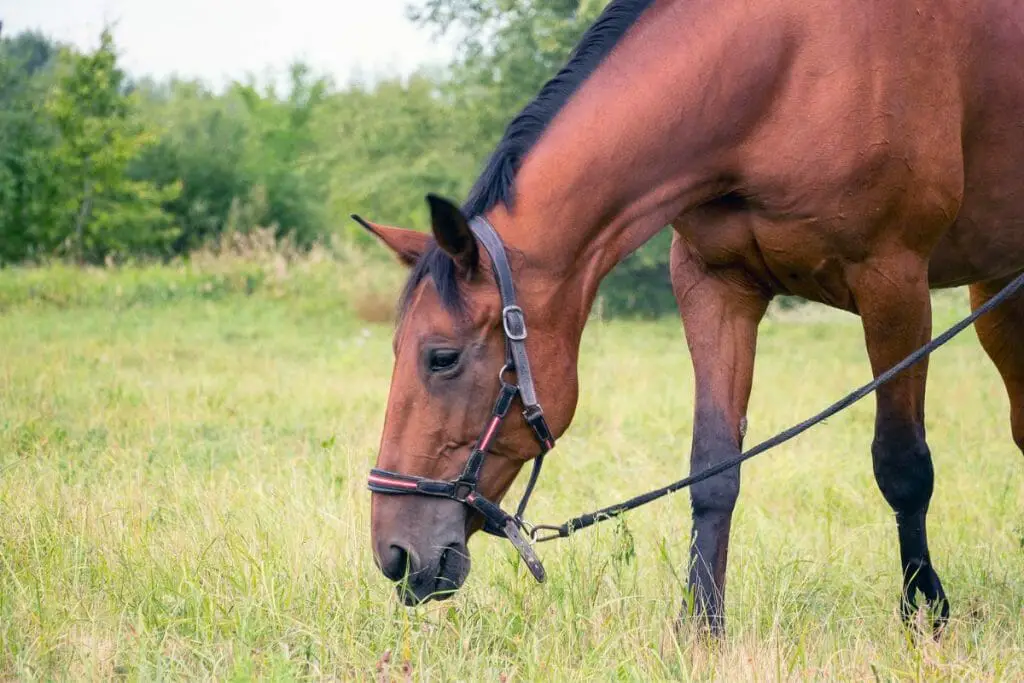
FAQs About Bay Horses
Can a bay horse have a black foal?
Yes. The number of times a bay gives its color to its young varies. Two bay horses that are heterozygous for E (Ee x Ee) have a 25% chance of having a chestnut foal. In the same way, bay horses that are heterozygous for A (Aa x Aa) can have a black foal.
Can a bay horse be homozygous black?
Yes. The final color of a horse is the result of the interaction of 11 largely separate processes. Multiple alleles influence coat color, hence homozygous black may or may not be black in color. Depending on the genetics, this horse might be bay, grullo, smokey black, or even gray.
Can bay horses have dapples?
Yes they can. It is both genetic and environmental in nature. There are horses who will have dapples regardless of their condition, and horses that will never dapple even if they are in perfect health. Temperature is one environmental component considered to impact color to some extent, so the lengthy, chilly spring might have had a role.
Can bay horses have dorsal stripe?
Bays can have a dark stripe but don’t have a true dorsal stripe, it would just be counter-shading that looks like one. Although it’s not clear and the edges aren’t sharp. A real dorsal stripe looks like it was made with a marker.
What is a dark brown horse called?
A dark brown horse is an ambiguous term. Depending on the traits and specific coloring, it can be a dark bay, mahogany bay, seal brown or liver chestnut.
What are the different shades of bay horses?
These are 12 shades of bay that can be named. Although it has been argued that some of the shades are the same color just with different names. Anyway you look at the shades there is no genetic difference aside from possibly seal brown and wild bay and these shade names are speculation and opinion from horse people. The different shades of bay include standard bay, wild bay, blood bay, mahogany bay, cherry bay, copper bay, golden bay, sandy bay, light bay, sooty bay, dark bay, and seal bay/seal brown.
Are all thoroughbreds bay?
Not all thoroughbreds are bay. However bay is a very popular color in the thoroughbred breed. Thoroughbreds come in many other colors as well, such as black, chestnut, grey and more.
Can a bay horse carry a cream gene?
No a bay horse cannot carry the cream gene. The cream gene is dominant and you would see it in the horses coloring. One cream allele with a bay would create a buckskin and two cream alleles with a bay would create a perlino.
Can bay horses turn grey?
If the horse is bay with a grey modifying gene then yes. The horse will be born bay and gradually turn grey.
Can bay horses have brown manes?
No bay horses always have black manes.
Do all bay horses have black legs?
Yes, all bay horses have black legs. However with the wild bay horse color the black and be pushed down further on the legs so it is less noticable than on the other bay variations.
What type of horse is bay?
Bay is not a type of horse. Bay is one of the three basic colors of horses. Most horse breeds can be seen sporting the color bay.
What is the difference between bay horse and chestnut?
The easiest way to tell the difference between a bay and a chestnut horse is to look at its lower legs, mane and tail. If the horse has black in these areas, it is a bay. If it doesn’t have any black hairs there it is chestnut.
What does bay mean in horse racing?
In horse racing bay is used as a classification of the horses coat color. Bay is a reddish brown color with black points or areas located on the legs, mane, tail and sometimes ear tips and muzzle.
What are bay horses used for?
Bay is just a color of the horse available in many breeds. Bay horses are seen in all riding disciplines and areas of horse related work.
What colors do bay horses look good in?
Any type of color that contrasts or highlights the reddish brown color looks good. Bay horses are fortunate to look good in most colors. Darker bays look best in lighter colors and lighter bays look best in darker colors. Mid color bays can look good in dark or light. If you want to contrast, go against your bays undertone, whether it is reddish, use greener tones or more yellowish use more blueish tones.
How long has the bay color been around?
Bay is one of the earliest known colors for horses, and cave paintings from about 25,000 years ago show bay horses. The bay gene was found by looking at the DNA of fossilized horses from the late Pleistocene period.
Quiz: How Much Do You Know About Bay Horses?
Try out this bay horse quiz and test what you have learned about bay horses.
Wrapping Up
There is more to a bay horse than just a brown horse with a black mane and tail.
They come in a variety of shades, and create other horse colors when genes are added to the bay base.
There are horses that can look bay but are not genetically bay. Bay horses are very common and you can expect to work with some of them throughout your equestrian journey.
At this point if you lease or own a bay horse, you should have an idea of the shade of bay your horse is as well as colors that may compliment them.
Now that you know all the basics about the color bay why not read my blog post comparing duns vs buckskins. These are two coat colors that are easily confused.
Cheers, Kacey
Bays A Horse Color That Is Not As Plain As You Think!
Related Blog Posts
- Complete Guide To Horse Coat Colors & Patterns: FAQ’s Included
- All About Blue Roan Horses (Genetics, Facts, Breeds & More!)
- 16 Dapple Grey Horse Facts With Beautiful Pictures | Breeds List | Resources
- What Is A Flea Bitten Grey Horse? Grey Horse Breeds, Facts, Colors & Photos
- Learn 10 Facts, Differences & Color Shades Of Buckskin & Dun Horses
- 27 Interesting Palomino Horse Facts With Beautiful Pictures & Some Extras
- Horse Face and Leg Markings Chart
- Horse Coat Patterns for the American Paint Horse

